






Whether you’re dealing with drought, flood, heat or other climate-related stress, the soy checkoff is working behind the scenes to diversify U.S. soybean genetics and increase stress tolerance. We’re looking inside the bean, beyond the bushel and around the world to keep preference for U.S. soy strong. And it’s helping make a valuable impact for soybean farmers like you.
See more ways the soy checkoff is maximizing profit opportunities for soybean farmers at unitedsoybean.org

Expanding conservation opportunities, the challenging financial landscape for farmers, and a message from a state leader in Indiana agriculture were the highlights of the Ag Policy Summit.
Initiatives like USSEC’s checkoff-funded Soybean Oil Masters program plays a vital role in educating and fostering connections within the agricultural, trade and culinary sectors internationally.
Chairman Mike Koehne, Greensburg / D4
Vice Chairman Kevin Cox, Brazil / D3
Secretary Joseph Stoller, Bremen / D1
Treasurer
C.J. Chalfant, Hartford City / D2
Committee Chairs
Keevin Lemenager, Monrovia / D4
Carey McKibben, LaGrange / D2
Denise Scarborough, LaCrosse / D1
ICMC and USGC hosted opinion-makers, communication and public affairs officials from Panama, Costa Rica, Guatemala, Peru, Colombia and Chile for a tour of Indiana’s ethanol supply chain.
With recent research from a new company called Insignum AgTech, corn plants might be able to say “treat me with fungicide” as clearly as if it were written in marker on a sticky note.
42
About the cover:
Ted McKinney, who grew up on a Tipton County, Ind., farm, worked his way to become director of the Indiana State Department of Agriculture and USDA Under Secretary for Trade and Foreign Ag Affairs. McKinney’s efforts have resulted in increased U.S. farm exports. He is the 2023 recipient of the Friend of Farmer award from the Indiana Corn Growers Association and ISA’s Membership and Policy Committee.
President Scott Smith, Windfall / D5
Vice President
Chris Cherry, New Palestine / D6
Secretary Sarah Delbecq, Auburn / D3
Directors
John Peters, Monticello / D1
Allen Buchanan, Fowler / D1
Dylan Christopher, Brookston / D1
Kevin Kelley, Brookston / D1
Steve Phares, Albion / D2
Jenna Scott, Muncie / D2
Brian Warpup, Warren / D2
Mark Wenning, Cambridge City / D2
Derika Lynam-Spaetti, Richland / D3
Gary McDaniel, Boonville / D3
Jason Misiniec, Bicknell / D3
Larry Rusch, Vincennes / D3
Roger Bommer, Brookville / D4
Kevin Burbrink, Seymour / D4
Anngie Steinbarger, Edinburgh / D4
Treasurer Tyler Everett, Lebanon / D7
Directors
Tom Murphy, Chesterton / D1
Joe Tuholski, LaPorte / D2
Mike Beard, Frankfort / D4
J.R. Roesner, Ferdinand / D8
Tyler Pottschmidt, Greensburg / D9
Staff Credits
Editor / Dave Blower Jr.
Writer / Amie Simpson
Writer / Emma Hopkins-O’Brien
Writer / Susan Hayhurst
Creative Director / Carol Johnson
Indiana Corn & Soybean Post® is published five times per year by the Indiana Soybean Alliance and the Indiana Corn Growers Association.

For address corrections contact: Indiana Corn & Soybean Post® 8425 Keystone Crossing, Suite 200 Indianapolis, IN 46240
Phone: 800-735-0195 or 317-614-0377
Email: dblower@indianasoybean.com
Find us on Facebook Badg CMYK .eps
For advertising information in the Indiana Corn & Soybean Post®, contact Dave Blower Jr. at 317-3473620 or dblower@indianasoybean. com. Comments and statewide news articles should be sent to the above address. Advertising space reservations must be made by the first day of the month preceding publication. In consideration of the acceptance of the advertisement, the agency and the advertiser must, in respect of the contents of the advertisement, indemnify and save the publisher harmless against any expense arising from claims or actions against the publisher because of the publication of the content of the advertisement.
facebook.com/indianaSoybeanAlliance facebook.com/IndianaCornGrowers
@Indiana_Soy @IN_Corn

When a fence needs mended, a tire needs changed or an implement needs repaired, farmers will often tackle those problems on their own. If the repair requires a little extra muscle or a specific expertise, we might invite a neighbor or friend to help. Ultimately, though, we understand that we are responsible for the future of our own industry. We know how to solve our own problems better than those who don’t live on the farm.
In a way, that’s part of the story of today’s more modern, more cohesive, stronger agricultural economy.
Around 40 to 50 years ago, the farm economy needed repaired. Government-imposed grain embargoes restricted or eliminated international trade. A lack of investment into ag companies slowed the progress of new technologies to farmers. Universities and research institutions were delayed from bringing vital information and new growing techniques to corn and soybean fields by out-of-date views of agriculture.
These circumstances and more led to stagnant or declining prices in the 1970s and 1980s. High interest rates made credit difficult to find. Farmers grew tired of serving as pawns in government-led trade negotiations and being subject to welfare-style government programs to make ends meet.
Many farmers recognized the problems. They saw the systems were broken, and they decided to repair those challenges themselves.
Under these circumstances, farmers several decades ago pulled their resources together to campaign for commodity checkoff programs. Under law, checkoff programs promote and provide research and information for a particular farm commodity without singling out specific farmers or brands. This means the Indiana Corn Marketing Council (ICMC) promotes corn in all of its forms –including corn as feed, corn as food and corn as fuel.
These programs are financed by farmers, led by farmers and designed to benefit both the farmers of today and future generations.
In 2007, after years of debate in the Indiana General Assembly, then-Gov. Mitch Daniels signed the Indiana Corn Market Development Act into law, and ICMC, the state’s corn checkoff program, was launched. ICMC has proven its worth to Hoosier corn growers many times since its creation. Here are a handful of accomplishments:
• Expanding Indiana’s ethanol industry from six plants in 2007 to 15 today.
• Creating environmental programs to help farmers adopt ecologically sound farming practices.
• Investing in the Indiana Corn and Soybean Innovation Center at Purdue University establishing the first field phenotyping facility of its kind in the United States.
• Sponsoring the National Corn Growers Association’s (NCGA) Corn Utilization Technology Conference which brings together the value chain interested in developing new uses for corn.

• Establishing markets overseas for corn in all forms. For all of the things that the checkoff provides to Indiana farmers, by law, it can’t do everything. The checkoff program cannot advocate for itself or anything else. The checkoff’s role is the research, inform and promote. That is where the Indiana Corn Growers Association steps in. As the policy organization that campaigns for the benefit of Hoosier farmers, ICGA supports the checkoff and its efforts.
We believe that working in tandem, ICMC with ICGA, will benefit all Indiana farmers.
We believe ICMC will continue to conduct research that will lead to more productive farms. ICMC will inform consumers and farmers of the benefits of corn-based products. And, ICMC will promote Indiana corn in all forms at home and abroad.
At the same time, ICGA will continue to push for legislation that will provide year-round access to higher blends of ethanol. We will fight against trade barriers such as Mexico’s ban of biotech corn. And, we will ensure the farm bill serves Indiana’s corn farmers. Join our fight. Together we can do great things.

At POET, we believe in cultivating communities and growing the local economy. We have been using biotechnology to create sustainable solutions from local agricultural products for 35 years – ensuring that rural farm families can continue to do what they love for generations to come.
POET purchases corn from local farmers to produce sustainable biofuels and bioproducts. There are four POET Bioprocessing facilities across Indiana: Alexandria, North Manchester, Portland, and Shelbyville with a fifth coming soon in Cloverdale. | poet.com/grain

As the chair of the ISA’s Membership and Policy Committee, I will sometimes receive an early warning of policies and regulations that could negatively affect Indiana farmers before they become law. Often, these warnings are merely “smoke” and are not a genuine concern. Other times, the worry carries enough weight that I feel the need to tell everyone I know.

The more I learn about the U.S. Environmental Protection Agency’s (EPA) Vulnerable Listed Species Pilot Project of the Endangered Species Act, the more I want to alert Indiana farmers to the potential trouble this could create. The EPA’s plan is to apply pesticide restrictions to protect 27 listed plant and animal species in designated zones around the country. Compared to other states, Indiana has relatively few restriction zones; however, the zones that do exist still cover thousands and thousands of acres of farmland.
EPA seeks to install broad, sweeping restrictions to protect these 27 species, and that will greatly affect the ability of farmers to use many pesticides to protect their crops. A recent proposal by EPA includes the following restrictions on farmers in these restricted zones:
• No one can apply pesticides 48 hours before or after a rainfall.
• Farmers must consult the Fish and Wildlife Service three months prior to making any pesticide application on their land.
• Farmers must incorporate four conservation practices to minimize runoff including no-till, vegetative filter strips, contour terracing and riparian buffers.
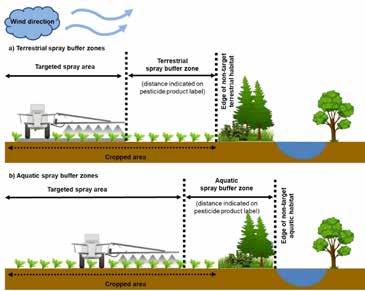
• Farmers must have 200-foot spray drift buffers for ground sprayers and 600-foot drift buffers for aerial applications.
If farmers or pesticide applicators don’t comply with these rules, they could be subject to civil or criminal penalties of up to $50,000 or a year in jail.

Whether intended or not, the result of this policy is to take away a tool that farmers use to protect their crops.
Among the frustrations is that the Endangered Species
Act (ESA) was not designed to manage pesticide regulations. This law was written to manage individual infrastructure projects – such as building a bridge over the habitat of an endangered animal. The law directs federal agencies to come up with ways to build without harming those animals.
Nevertheless, federal court rulings have applied the ESA to regulate pesticides. For many years, EPA has not conducted thorough ESA assessments in pesticide registrations. This has allowed environmental groups to sue the EPA with the result of many pesticides being eliminated by federal judges – ending farmers’ access to these tools.
These pesticides are registered for dozens of crops and used on hundreds of millions of acres across the country and intersect with nearly all 1,600 ESA species in their habitats. Farmers need to stay involved in this issue. We need to protect our crops from a different threat –misguided EPA regulations.
Stay engaged with our policy organizations to help prevent burdensome regulations likes these from becoming law.
The buffer would begin where the application ends and therefore may be an in-field buffer, adjacent to the field, or a combination of both. The immediate area within 10 feet of the field is often a disturbed area that is managed and may be considered part of any buffer.



Our founding farmers took action 22 years ago to launch ASA’s World Initiative for Soy in Human Health so WISHH could grow new markets for U.S. Soy. Today, WISHH is working with strategic partners that use soy for food or feed in 28 countries across Asia and Latin America to sub-Saharan Africa.
Find out how WISHH’s three pillars of trade, development and food security cultivate new markets for U.S. Soy protein.

 Trade. Development. Food Security.
Trade. Development. Food Security.

The deadline for the 2023 Farm Bill is rapidly approaching. While legislators continue to remain vague on if the bill will get passed before Sept. 30, ASA and its farmer-leaders are keeping boots on the ground to advocate for a comprehensive farm bill. While lawmakers are currently in recess, U.S. soy growers are shifting attention to other major policy issues and the upcoming 2023 harvest.
In early August, ASA led coalition comments raising “grave concern” with EPA’s vulnerable species pilot project proposed under the Endangered Species Act. The comment letter, which drew 206 signers, expressed multiple ways in which grower and other pesticide user operations potentially would be subject to irreparable harm should the pilot take effect as proposed. The comments raised concern that the proposal “will effectively result in a de facto pesticide ban for many farmers.”

Additionally, the comments expressed alarm with ways in which the proposal likely violates EPA’s legal obligations under ESA, FIFRA, the Administrative Procedure Act, and other federal statutes.
The vulnerable species pilot, which seeks to protect 27 species EPA alleges are uniquely vulnerable to pesticide exposures, would impose geographical use restrictions on pesticide users
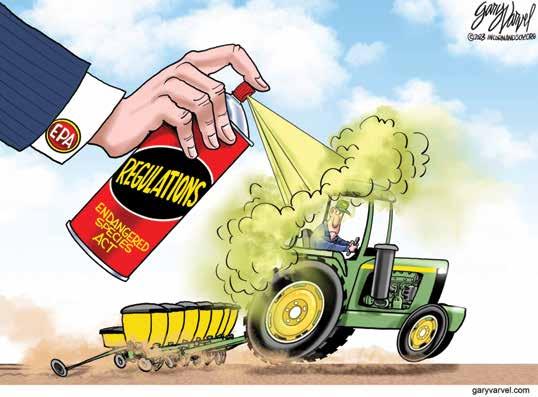
within the species ranges. The pilot would establish pesticide use limitation areas (PULA) with varying restrictions depending on the species.
While the proposal is complicated and largely species-specific, there are many general trends regarding the restrictions that would apply to pesticide users affected by the pilot. For example, many farmers in the PULAs would have to coordinate with their local Fish and Wildlife Service (FWS) offices three months ahead of making any pesticide applications on fields or rangelands.
The comments highlight how this could create an enormous regulatory bottleneck if the local FWS office has limited capacity to handle hundreds of coordination requests. It is also impossible for growers to predict their pest pressures and application needs three months in advance. Most farmers under the proposal would have to adopt four runoff/erosion mitigations as well, many of
which would be incredibly expensive or impractical for growers to implement. The comments highlight that the collective impact of this proposal would be an effective pesticide ban for many growers. The effects on growers and communities in the PULAs would be enormous. Many growers would be unable to protect their crops from significant crop damage, which would harm their ability to qualify for crop insurance and financing. For most producers, these impacts would affect their ability to continue farming.
The comment letter also highlights concerns that the proposal is likely inconsistent with the agency’s legal obligations. For example, given that EPA did not conduct a risk assessment or effects determination ahead of proposing any of these restrictions, the signers are concerned EPA has not satisfied its responsibilities under ESA to use the “best available science” or FIFRA to conduct risk assessments. There is also concern the restrictions the agency is proposing are not “reasonable and prudent,” as required by ESA.
Lawmakers introduced bipartisan legislation in July to strengthen the USDA BioPreferred program. The program is just one of multiple federal programs that encourage growth of biobased markets. Biobased products, including soy foam, ink and thousands of other products, represent an exciting and rapidly growing market for soybean growers.
Soy growers support the growth of this industry, not only to develop demand for U.S. soybeans, but also to play an important part in building a more sustainable future.
U.S. Sen. Amy Klobuchar (D-Minn.), U.S. Sen. Joni Ernst (R-Iowa), Sen. Debbie Stabenow (D-Mich.), and Sen. Pete Ricketts (R-Neb.), introduced the Biomanufacturing and Jobs Act to counter China’s biomanufacturing advancements by promoting U.S.grown soybeans and biobased materials readily available in our own country.
This legislation is endorsed by the American Soybean Association, Agriculture Energy Coalition, American Farm Bureau Federation, Clean Fuels Alliance American, Corn Refiners Association, National Association of State Departments of Agriculture, National Corn Growers Association, National Farmers Union, National Industrial Hemp Council of America, National Hemp Association, Plant Based Product Council and Renewable Fuels Association.
A top priority for ASA in the 2023 Farm Bill is finding opportunities to boost reliable and sustainable biobased
products and promoting soy utilization. Enhancements to the BioPreferred Program can improve utilization of more than 1,000 existing soy-based products. ASA thanks Sens. Klobuchar, Ernst, Stabenow, and Ricketts for leading the effort to modernize USDA’s BioPreferred program and supporting farmers and biomanufacturers.
ASA, National Cattlemen’s Beef Association, National Pork Producers Council and National Milk Producers Federation announced their joint opposition July 25 to the Spartz amendment to the House Agriculture Appropriations bill attacking commodity checkoff programs.
The legislation, introduced by Rep. Victoria Spartz (R-Ind.), aims to prohibit the USDA from using any tax dollars to administer commodity checkoff programs. However, no taxpayer dollars are used in administering checkoff programs, which are funded entirely by the producers who pay into them.

The four commodity groups were also joined by 21 others in sending a letter to the House Committee on Rules, arguing that the checkoff amendment is not germane to the appropriations bill and should not be allowed to come up for a vote.
On July 26, Rep. Spartz took the floor during a procedural hearing on the House Agriculture Appropriations bill (H.R. 4368) to defend her amendment, where she repeatedly claimed commodity checkoff boards lacked transparency. However, each national checkoff program follows rigorous auditing and financial documentation required by USDA and the U.S. Government Accountability Office.
In a media release shared by the organizations and featured in Politico, ASA President Daryl Cates, a farmer from Illinois, shared his surprise at Rep. Spartz’s amendment, especially as U.S. soybean farmers remain unequivocally supportive of the Soy Checkoff.
“Just 708 of our nation’s 500,000-plus soybean farmers requested to vote on whether to continue the soybean checkoff during the most recent request for referendum back in 2019. That’s just over onetenth of 1 percent of soybean farmers. That means hundreds of thousands of farmers continue to support the Soy Checkoff,” said Cates. “They understand the significant role the checkoff plays in developing and protecting markets for their crops, conducting research and promotion to sustain their livelihoods and the environment, and keeping U.S. soy available domestically and competitive globally.”
 BY BROOKE S. APPLETON Vice President of Public Policy, National Corn Growers Association
BY BROOKE S. APPLETON Vice President of Public Policy, National Corn Growers Association


Fall is quickly arriving in the nation’s capital and with it comes the sense that Congress has much to accomplish in a very short period with potential roadblocks along the way.
Perhaps the most serious potential impediment is a looming government shutdown as Congress approaches the Sept. 30 deadline to fund the federal government.
During the past decade, we’ve gotten all too familiar with the ramifications far and wide that a government shutdown brings. Almost the entire federal government, including the legislative branch, comes to a complete stop. There will be politicians on both sides of the aisle trying to deflect blame, and there will be voters across the country trying to assign blame.
In the event of a government shutdown, staff who might be deemed “essential” and able to continue to do their jobs are technically prohibited from working on any legislation unrelated to funding the government. It goes without saying that such a scenario could hamper progress on key agricultural initiatives, including reauthorization of the farm bill. Despite these challenges, NCGA continues to exercise laser focus on ensuring lawmakers understand our policy priorities during the farm bill debates.
Throughout the month of September, videos of growers speaking on NCGA’s farm bill priorities will continue making their way into the social media feeds and pre-roll ads of key members of Congress, staffers and other influencers in Washington. This video series is yet another way we have found to bring the voice of the farmer directly into the legislative process. This effort comes on the heels of a call-to-action that has already
led to thousands of corn farmers contacting their members of Congress.
While continued outreach to the House and Senate remain top of mind, the halls of Congress are not the only place bustling with activity that is important to our members. Across town at the Department of Treasury, a big decision is expected soon on whether the Biden administration will use the Department of Energy’s greenhouse gas model known as GREET or a less comprehensive international model as it decides on which biofuels will receive tax credits under the recently passed Inflation Reduction Act.
While the issue sounds esoteric, its ramifications for corn growers and the president’s climate agenda are far-reaching. The IRA allows for the allocation of tax incentives for biofuels that cut GHGs by 50 percent or more. Farmers have been pushing for Treasury to follow GREET as it assesses GHG reductions, as the model most accurately accounts for on-farm carbon reduction activities, feedstock yield increases and the improved agricultural production practices that farmers have adopted over the last 20 years.
We have worked closely with officials in Congress and the administration on this matter, and we have been communicating our thoughts directly to Treasury Secretary Janet Yellen.
We are also closely coordinating with officials from the airline industry and other groups to elevate corn ethanol as the go-to biofuel in the air travel sector. Stay tuned.
Moving to yet another government agency, we are continuing to work with the team at the office of the U.S. Trade Representative as it prepares to empanel experts in its dispute settlement with Mexico regarding the country’s decree banning the use of biotech corn for
“U.S. corn growers are disappointed by EPA’s revised WOTUS rule,” said NCGA President Tom Haag. “The agency failed to open the process to public comment and engagement, which would have been extremely valuable. Instead, the agency has released a rule that does not fully respect the holdings from the recent U.S. Supreme Court case on WOTUS.”
human consumption.
NCGA has lobbied for the last year to get to this point and is pushing for a resolution of the issue.
As your lobbyists, please rest assured that we are on top of all these issues. We are showing up and making a case on your behalf before Washington decision-makers. We invite you to follow our efforts and join our advocacy outreach by texting COB to 52886. There is strength in numbers and your voice matters.
NCGA expressed disappointment with the revised Waters of the U.S. (WOTUS) rule that was issued on Aug. 29 by the Environmental Protection Agency (EPA) and the
Army Corps of Engineers.
“U.S. corn growers are disappointed by EPA’s revised WOTUS rule,” said NCGA President Tom Haag. “The agency failed to open the process to public comment and engagement, which would have been extremely valuable. Instead, the agency has released a rule that does not fully respect the holdings from the recent U.S. Supreme Court case on WOTUS.”

EPA released the revised rule after the U.S. Supreme Court issued a ruling in Sackett v. EPA earlier this summer that narrowed the scope of the Clean Water Act’s jurisdiction by, among other things, a unanimous decision that “significant nexus” was unlawful.
Here’s to a productive autumn and a bountiful harvest. Happy fall, y’all!
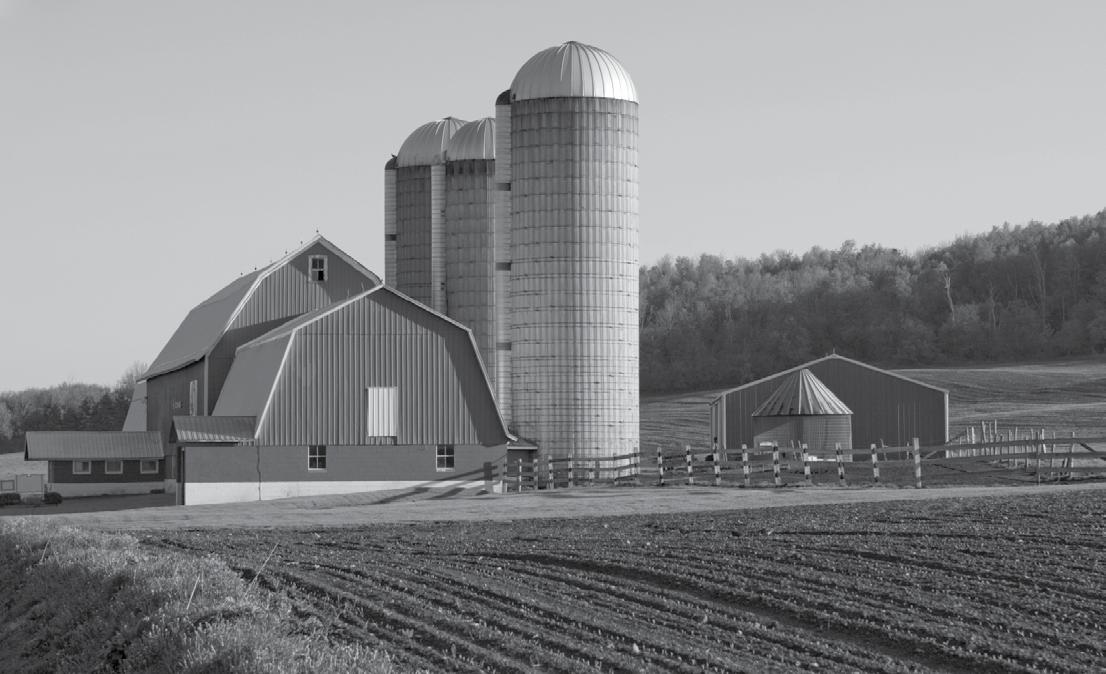


The Indiana Corn Growers Association (ICGA) and the Indiana Soybean Alliance’s Membership & Policy Committee (M&P) represent our state’s farmers in the legislative halls in Indianapolis and Washington, D.C. These organizations need your membership to influence federal and state lawmakers.
Indiana soybean and corn growers can now save money and eliminate the hassle of annual renewals by purchasing a LIFETIME MEMBERSHIP to both ICGA and M&P. For only $1,700, you can be a member of both ICGA and M&P for life!
Anyone interested in buying this membership, should contact Industry Affairs Outreach Manager Khyla Goodman by phone at 317-614-0377 or by email at goodman@indianasoybean.com. Or, you can go to our website, www.indianasoybean.com/ memberships, to join!
Lifetime Members:
Phil Ramsey
Courtney Kingery
Matthew Lucas
Tyler Everett
David Gottbrath
Mike Sprinkle
Jeff Troike
Jim Douglas
Michael Steinbarger
Sam Caldwell
Mark Nigh
Alan Dunn
Mason Gick
Aaron Johnson
Nathan Luallen
Sam Mehringer
David Wenning
Mark Wenning
Creed Gunn
Andrew Fansler
Kent Burton
Russell Anderson
Tyler Everett, Lebanon, Ind., farmer
“I bought my lifetime membership because the policy and new market development work that the Indiana corn and soybean associations do is very beneficial to every Indiana farmer. Also, as a young farmer, I weighed all of the savings I can earn now. This was a no brainer.”

 BY AMIE SIMPSON
BY AMIE SIMPSON
More than 100 members attended the 14th annual Growth Energy Biofuels Summit Sept. 11-14 in Washington D.C. Indiana Corn Growers Association (ICGA) Board Member Tyler Everett joined staff in hearing an update on ethanol policy issues and participating in meetings with lawmakers on Capitol Hill.
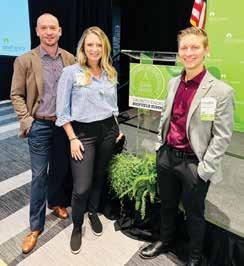
The Boone County farmer said it’s important to discuss issues that impact corn growers with representatives and senators.
“We had several good meetings with our delegation,” Everett said. “Our big push right now is yearround E15 sales and trying to update the language to help give us better markets and access to higher blends of ethanol.”
Steve Howell, senior director of industry affairs with ICGA, said the main issues conveyed to congressional offices included support for several bills including HR 1608, sponsored by U.S. Rep. Adrian Smith (R-Neb.), as well as S 2707 and S 785, both sponsored by Sen. Deb Fischer (R-Neb.).
“These bills will allow retailers to sell E15 year-round,” he said. “Current law prohibits E15 sales in summer months in certain areas. This has stifled fuel retailers’ efforts to offer the higher-ethanol blended fuel and has limited consumer savings and choice.”
Trade issues were also a top discussion item with congressional offices. U.S. trade policy must ensure fair access to low-carbon ethanol in markets like Canada, India, Brazil, Japan and the United Kingdom. Howell said they also asked congressional leaders to address Brazilian import tariffs on American ethanol and the non-tariff barriers in place that further complicate bilateral ethanol trade with Brazil.
Summit participants also discussed the 2023 Farm Bill, which is a priority for the state’s farmers planning to grow a crop next year.
“We’re encouraging representatives and senators to get
a farm bill completed this year, so we have some certainty on the farm and know what programs are available,” Howell said. “We’re already planning a lot of next year’s crop and we need to know what the farm bill is going to provide.”
The current farm bill expires Sept. 30. Both chambers are focusing on completing appropriations bills to fund the federal government. Howell said ICGA would like to see an extension of the current farm bill and a new bill passed by the end of the calendar year.
Tim Phelps, executive director of the Indiana Ethanol Producers Association, and Adam Homan with the POET Biorefining plant in Portland, Ind., joined ICGA during the Hill visits.
This year’s Biofuels Summit shined a spotlight on how the biofuel industry is delivering on the nation’s energy, climate, economic, and human health goals. General sessions included remarks from Growth Energy CEO Emily Skor and Chairman Dan Sanders. Helena Jette, biofuels director with ICGA, said USDA Secretary Tom Vilsack spoke about the administration’s view on the role biofuels will play in decarbonization efforts.
“Throughout his remarks, Vilsack demonstrated his commitment to the issues that matter most to biofuels producers and their farm partners,” Jette said. “He talked about the diversified, profitable and sustainable future of American agriculture and how “sustainable aviation fuel (SAF) is a critically important component of that.”
National Climate Advisor to the White House Ali Zaidi also spoke on the important role of biofuels for the administration’s plan to reach net-zero.
Education panels during the event consisted of experts discussing the Inflation Reduction Act’s 45Z carbon reducing investments, carbon modeling and SAF role into the future, liquid fuels discussions around year-round E15, and fuel retailer perspectives of how the program needs to continue for consumers to enjoy the cost benefits and environmental benefits to reducing carbon footprints.
 BY U.S. REP. JIM BANKS Republican Party, Indiana District 3
BY U.S. REP. JIM BANKS Republican Party, Indiana District 3

A nation cannot stand on its own without food and energy security.
Luckily, our nation is blessed with an abundant supply of the best, cleanest and most cost-efficient food and energy in the world. That is, as long as Washington bureaucrats stay out of the way.
Following Joe Biden’s out-ofcontrol spending, deceptively dubbed as the “American Rescue Plan,” farm interest rates have risen at the fastest pace in more than 40 years.
Since January 2021, fuel and fertilizer prices have jumped 60 to 130 percent. That’s on top of the record costs of land, labor, and equipment, to name a few.
Adding insult to injury, radical climate activists have declared war on farmers and are actively working against the interest of working-class families across the country.
From their desperate push to fill beautiful farmland with unreliable solar panels made in China, to proposing a ban on all diesel and gas engines in the next decade, proponents of Joe Biden and AOC’s radical green agenda are increasing our dependence on communist China and weakening America’s national
security. And they’re doing it on purpose.
I don’t need to tell you all this – you are living it every day. Corn and soybean farmers in Indiana are on the front lines of the battle for the future of our nation.

Do we want to be a nation that produces enough corn and soybeans for the Americans and the rest of the world, or do we want to sacrifice U.S. agricultural dominance for a “green” agenda based in hysteria and pseudoscience?
I am for the former.
When I was first elected in 2016, I led the Indiana delegation in support of President Trump’s proposal to rescind the EPA’s anti-farmer “Water of the United States” (WOTUS). And just this summer, I was an original cosponsor of legislation to authorize the Committee on Foreign Investment in the United States (CFIUS) to review and block land purchases by hostile enemy nations and make U.S. food security a priority in its national reviews.
I am not a farmer and won’t pretend to be. But as the Congressional representative for Northeast Indiana and an Afghanistan veteran, I believe America is worth fighting for, and I will always do so alongside you to protect our nation’s food and energy security.

 BY DAVE BLOWER JR.
BY DAVE BLOWER JR.
Expanding conservation opportunities, the challenging financial landscape for farmers, and a message from a state leader in Indiana agriculture were the highlights of the Ag Policy Summit on July 26 at the Howard County Fairgrounds in Greentown, Ind. The Summit is an annual policy-focused program presented by the Indiana Soybean Alliance’s Membership and Policy Committee (M&P) and the Indiana Corn Growers Association (ICGA).
M&P Chair Keevin Lemenager, a farmer from Monrovia, Ind., and ICGA President Scott Smith, a farmer from Windfall, Ind., welcomed more than 90 farmers, industry stakeholders and the staff of state and federal lawmakers to the annual event.
“We hold this event every summer, so that farmers and industry professionals can come together to discuss the pressing issues of the ag sector,” Smith said. “We could not put on these events without our members or our many sponsors.”
The corporate sponsors for this year’s Summit were
FMC, First Farmers Bank & Trust, Beck’s Hybrids, Corteva Agriscience, United Soybean Board, Farm Credit Mid-America, Conexus Indiana, TTG Equipment, Merrell Brothers Drainage Division, Timpte Trailers, The Andersons, the Indiana Soybean Alliance (ISA), the Indiana Corn Marketing Council (ICMC) and First Financial Bank.
Lemenager added a call for membership to M&P and ICGA. “As many of you know, we are membership organizations that serve as the policy voice of Indiana’s soybean and corn farmers,” he said. “Our policy work is not funded by checkoff dollars. That means we must rely on membership dollars and corporate contributions to ensure farmer voices are heard and to address issues at all levels of government that directly affect Hoosier farmers.”
ISA Chair Mike Koehne, a Greensburg, Ind., farmers, said the state’s soybean checkoff program appreciates the work provided by M&P and ICGA. He said the policy organizations can talk to lawmakers about better policies while the checkoffs create relationships to get
work done for Hoosier farmers.
“ISA, along with ICMC, have continued building relationships with foreign trade partners so that our soybean and corn export markets stay strong,” Koehne said. “These countries include Colombia, Panama, South Korea and Vietnam to name a few. We have also been funding research and building key relationships with transportation partners so that our Indiana agricultural infrastructure like roads, bridges and waterways, stay strong.”
Among the Summit’s topics included expanding conservation opportunities for Indiana farmers through boosted government funding. John Ketzenberger, Director of Government Relations for The Nature Conservancy, a global environmental nonprofit group, told farmers that recent government spending bills adopted in Congress will allow many planned projects to move forward.
Ketzenberger said $40 billion of the 2022 Inflation Reduction Act was set aside for ag-related conservation programs. Included in that spending is $19.5 billion for USDA Natural Resources Conservation Service (NRCS) programs and $8.45 billion for the Environmental Quality Incentives Program (EQIP). He said the funding should allow USDA to clear a backlog of EQIP projects within two years. However, there is concern about being able to hire enough qualified people and contractors to finish those projects.
During his talk, Ketzenberger introduced Seth Harden, the Upper Wabash River Project Director for
John
The Nature Conservancy, and Clint Orr, a farmer from rural Clinton County, Ind., who has worked with The Nature Conservancy on many projects. “NRCS is on a hiring spree,” Harden said. “There is a concern about the capacity of labor available to get the projects done quickly. There are only so many people who understand the languages of conservation and agriculture.”
Harden called Orr “an innovator” and an “early adopter” of conservation projects, and a farmer who has not had to sacrifice major yield performance for environmental benefit. Orr said he only owns 600 acres of the 3,200 acres that he farms, and he often works with landowners who have varying opinions about his conservation efforts. “Most of our landlords understand what we are doing and appreciate it,” Orr said. “But our landlords run the gamut of opinions, and some of them require more explanation of what we’re doing.”
Farming since 1989, Orr said he’s experimented with many farm management techniques, and he’s kept what works best. “Conservation, really, is farming ugly,” he said. “Our farm doesn’t really look like every other farm out there, but everything we do is with the long-term benefit in mind. I think everyone would rather be incentivized with a carrot instead of a stick. I think it is always better to be rewarded for innovation. With my personality type, this is what keeps farming interesting and fun.”
Eric Pfeiffer, Vice President of Hoosier Ag Today and a farm radio broadcaster, served as the Summit’s emcee. In that role, he led a financial panel discussion featuring Benton County, Ind., farmer and Indiana Corn Marketing Council board member Natasha Cox, a Regional Vice
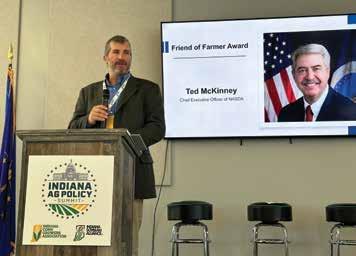
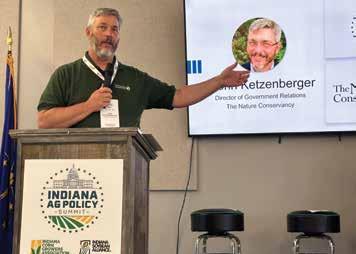
President of Ag Lending for Farm Credit Mid-America; Mark “Doc” Holt, President of First Farmers Bank & Trust; Aaron Gillum, Senior Vice President at 50 South Capital Advisors; and John Rassi, a Certified Public Accountant with CliftonLarsonAllen (CLA).
Cox and Holt started with a discussion about rising interest rates and what that means to credit, loans and investments. Holt asked the Summit audience if they thought interest rates would decrease, increase or stay the same. The majority of those in the room expect interest rates to increase, though Holt said he thought they would “level off.” Cox said, “Although interest rates are increasing, historically, they are in line.”
Managing higher interest rates and other financial risks requires advice and planning, Cox added.
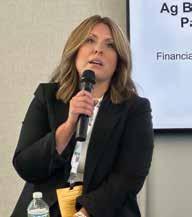
“Think about your farm as a business because that’s really what your farm is,” she said.
“Then think about who is going to be on the board of directors of your business. Are the other members of your family farm on your board? Do you consider their advice? I think it is a good idea to include outside members on your board – perhaps a banker, an agronomist or someone else who understands what you’re trying to do.”
Rassi agreed that planning is essential. He said that farm succession planning is among the key components of his business. “I think what people need to understand is that not planning is a plan,” Rassi explained. “That may not be a good plan, but not planning will have its result, too.”
He said there are three reasons why most farmers don’t start a farm succession plan:

• Farmers don’t know who to trust to help with this planning.
• Farmers are reluctant to give up control of their farm too soon.
• And no one, farmers included, wants to think about death.
Gillum is a venture capitalist helping investors to find technology start-ups in the Midwest and New York City. He said that investors and creators of new farm and food start-up companies want to talk to farmers about their needs.
“In preparing for this meeting, I looked into ag tech funding deals over the last three years,” he said. “In 2022, there was a drop off in dollars in ag tech investment. However, there was an increase in the number of deals. That means there are more people looking at getting involved in the ag tech space. For anyone interested, this sector is continuing to grow. Almost all of it is related to people wanting to know what’s in their food. Most of the new businesses are catering to that desire. There is a lot of opportunity to engage here.”
Cox encouraged farmers to have these discussions or to consider investing in these new businesses because they could fuel growth in agriculture. “The important thing is that this is important to our producers,” she said.
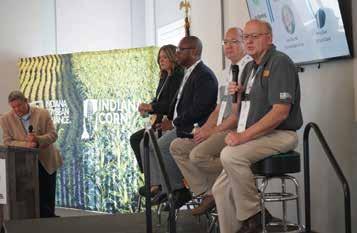
“Farmers need the new technology or tools that can be developed through new start-ups.”
ISDA Director Don Lamb, who was named to the position earlier this year, told the Summit attendees that Indiana agriculture “is a strong team.”
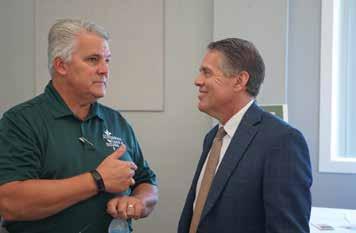

He said the state has many stakeholders that work together in advancing Indiana agriculture as an industry. Lamb said those stakeholders include ICGA and M&P in addition to the Indiana Soybean Alliance and the Indiana Corn Marketing Council.
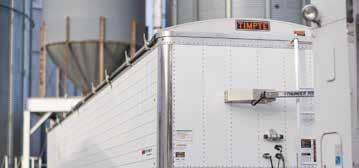
“Agriculture is awesome, and we don’t talk about that often enough to people outside of agriculture,” Lamb said. “Agriculture is special. It’s all about people; it’s all about planning, and it’s all about action. That last point –action – is very important. When you leave here today, I hope you call someone and say, ‘what can we do about this?’ Because without action, a lot of the information you hear today will lose its value.”
Lamb is a second-generation farmer for Lamb Farms in Boone County, Ind. Along with his father, brother and nephews, they produce corn, popcorn, seed soybeans and seed wheat. The family farm also owns two other enterprises: AgRecycle, a composting business, and Lamb Farms Agronomy, which provides neighboring farmers with agronomy products and services. Lamb stays involved in management aspects of the farm and joins in operations whenever he can.
Lamb’s main priority is leading ISDA’s five divisions, which include, agricultural advocacy, economic development, youth development, environmental stewardship and the Indiana Grain Buyers and Warehouse Licensing Agency. He said the best way to accomplish goals is to focus on a few.
“The best advice I received was to focus on something,” Lamb said. “You want to be everything to everyone, but if you don’t focus on something, then you won’t get
anything done. The one things that comes to mind, so far, is economic development. It really means quality of life. It is so important that every division of government has a focus on economic development.
“The Indiana Economic Development Corporation is really making things happen. There’s a lot of money flowing into Indiana, and that’s a good thing. We’ve developed a really friendly business environment here. And, as farmers, we want to be a part of that.”

The Indiana Soybean Alliance Membership and Policy Committee (M&P) and the Indiana Corn Growers Association (ICGA) hosted six Shop Talks throughout Indiana in August. The policy organizations had approximately 225 attendees and worked with Purdue Extension educators to provide almost 90 Pesticide Application Recertification Program (PARP) credits to farmers. Shop Talks are hosted on local farms and attended by farmers and agribusiness professionals. M&P and ICGA are grateful to the farmers who opened their shops to engage fellow Hoosier farmers in ag policy discussions. These farmers hosted Shop Talk meetings:
• Jim Douglas – Shelby County
• Scott and Terri Smith – Tipton County
• Eric Strater and Steve Phares – Noble County
• Mike Koehne – Decatur County
• Carey McKibben – LaGrange County
• Denise and Mark Scarborough – LaPorte County
“ICGA is always at work advancing issues important to farmers,” said ICGA President Scott Smith, a farmer from Windfall, Ind. “Shop Talks are a great opportunity to bring together our neighbors and local industry partners to learn more about the state and federal policies that impact our operations and rural communities. As ICGA President, it was good to host the Tipton County Shop Talk at my farm and was happy to network with around 30 farmers and industry peers at the event.”
Shop Talks are organized to bring together state and federal lawmakers with farmers to discuss agriculture policy issues.
Congressional representatives who engaged in policy discussions with farmers at these events this year included U.S. Rep. Greg Pence (R-Dist. 7) and U.S. Rep. Jim Banks (R-Dist. 3). Federal issues discussed included the 2023 Farm Bill, Mexico’s ban of biotech corn, year-round E-15 and EPA’S Endangered Species Act.
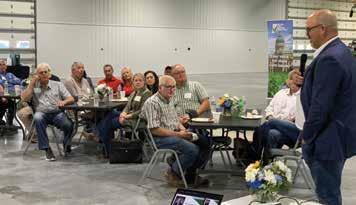
“We were fortunate to have Congressman Greg Pence make the trip to my farm for the Shelby County Shop Talk and engage with my guests on the farm bill and other important ag topics,” said M&P Committee member Jim Douglas, a farmer from Flat Rock, Ind. “It was a chance for us to ask questions, share our priorities and hear updates he may have from the Hill.”
M&P and ICGA directors and staff address ag policy issuesat all levels of government – often making trips to Washington, D.C. to meet with federal lawmakers to raise awareness of farmer priorities. Shop Talks are an opportunity for the legislators to meet the farmers in their districts and communities.
“We had a great discussion on priorities for the upcoming farm bill and some of the issues facing Hoosier farmers,” said Rep. Banks. “It is important to hear from producers on the ground about what Congress can do to help cut through burdensome federal regulations.”
Other Congressional staff also attended including Melissa Acton and Erin Dove of U.S. Sen. Todd Young’s office, and Steve Carter and Mary Martin of U.S. Sen. Mike Braun’s office. Several state lawmakers met with farmers including State Representatives Kendell Culp, Heath VanNatter, Lindsay

Shop Talk meetings give farmers an opportunity to discuss ag policy issues with lawmakers such as U.S. Rep. Jim Banks (R-Dist. 3).
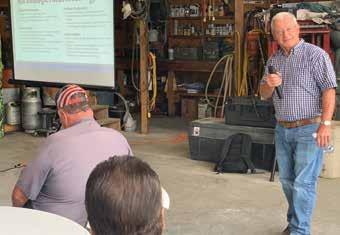


Patterson and Jim Pressel. The state legislators engaged in conversations about Indiana’s Biofuels Tax Credits, Carbon Sequestration Bill and Inventory of Lost Farmland Bill. The 2023 Shop Talks were sponsored by Corteva Agriscience, Pioneer Seeds, CoAlliance, Premier Ag and First Farmers Bank and Trust. ICGA and M&P are membership organizations that serve as the policy voice of Indiana’s farmers. Both M&P and ICGA are led by a board of directors committed to continuing the conversations of farm bill, biofuels, trade and other ag policy priorities with federal and state legislators.
Policy work is not funded by checkoff dollars. Membership dollars empowers M&P and ICGA to positively influence policy and regulatory matters impacting the U.S. soybean and corn industry. ICGA and M&P are at the table with lawmakers while you work at your farm. Go to https://incornandsoy.org/policy-center/become-a-policy-member/ to learn more about becoming a member.


 BY SUSAN HAYHURST
BY SUSAN HAYHURST
I’m certainly a happy warrior for agriculture and can only hope I’m also seen as a team player.” Those were some of Ted McKinney’s words to Ivanka Trump and her husband, Jared Kushner, during his October 2017 interview at Trump Tower in New York City when being considered for positions in USDA in President Trump’s Administration.
McKinney’s self-deprecation and passion for all things agriculture and his career trajectory serving ag at state, national and international levels is why he has been awarded the 2023 Friend of the Farmer Award by the Indiana Corn Growers Association (ICGA) and the Indiana Soybean Alliance Membership & Policy Committee (M&P).
“This is a terrific honor, one for which I am grateful and never anticipated. Even more special is that it comes from respected peers from my home state, which is full
of outstanding farmers and agricultural professionals. I am grateful to our Indiana Soy and Corn organizations.” He credits his upbringing on his family’s McKinney Farms – a Hoosier Homestead Farm – near Kempton, Ind., and the foundation he received from 4-H, FFA, Church and Purdue as critical steppingstones in setting his professional course. “My voice for ag comes from the culture of growing up on the farm and learning the value of hard work, ‘sticktuitiveness,’ faith, animal health, safety, nurturing of the soil, livestock and developing the love of the earth. This is God’s creation, and there’s divine wonder in it, much like the awe of planting a corn seed and up comes an ear of corn.”
Ted’s twin brother, Tom, who is president of McKinney Farms, said there was no question he was going to farm,
but “Ted seemed destined to go more into agribusiness. His Purdue bachelor’s degree in agriculture economics, his leadership positions in FFA, including northern region vice president, and fairly extensive campus activities exposed him to the vast opportunities beyond the farm gate. He always remains grounded, though, and calls about once a week to ask how the farm is doing and what are our key issues.”
McKinney notes his collegiate experience – including serving in campus leadership roles in Omicron Delta Kappa honorary, embracing being a 3-year Purdue Pete, the university’s official mascot, Old Masters, and student government positions – broadened and refined him. Though modest when asked, he acknowledged being grateful as well for receiving the coveted G.A. Ross Award as outstanding male graduate for the University. “Many in the Agriculture School stay pretty close to ag, but we all need to learn to cross the boundary from agriculture into other areas of commerce and work, largely because we will, over time, work with many other sectors of our economy.”
In reflecting on learning from his many experiences, he shared that as USDA’s Under Secretary during China Phase One negotiations, “90 percent of the fundamentals of negotiation and work with the Chinese came from experiences and growth through 4-H, FFA, my Purdue fraternity, Alpha Gamma Rho, and while working in many different roles in corporate America. It all led to at least reasonable competence and comfort in practicing in that international environment.”
Hired by Elanco out of Purdue for a sales position in central Ohio, and then Mankato, Minn., McKinney ultimately worked for 19 years with Dow Agrosciences and 14 years with Elanco Animal Health, where he was Director of Global Corporate Affairs. In 2013, he was appointed by then-Gov. Mike Pence to serve as Director of the Indiana State Department of Agriculture (ISDA).

Dr. Sue Ellsperman, now president of Ivy Tech Community College, and lieutenant governor under Gov. Pence, describes McKinney as a “true titan of agriculture. He was born on a farm, was deeply engaged with 4-H and FFA, and educated by Purdue University. Additionally, he has work experience with Eli Lilly and Company and its then-agriculture division, Elanco –great life science companies in the private sector. He then served in the public sector as Director of our state’s department of agriculture. He understood ‘soup to nuts’ all issues in agriculture, including those related to international trade. His service to our nation as Under Secretary of Agriculture helped support American farmers. No one has been a greater advocate for Indiana
Expanding trade opportunities for U.S. farm products was the primary goal of Ted McKinney’s work at the USDA. Here he’s touting an Indiana-based milk product in China.
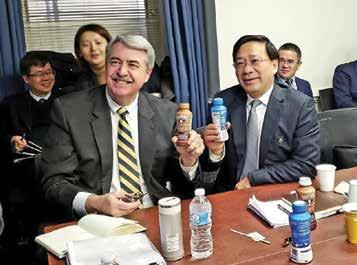
and American agriculture than Ted McKinney. He is most deserving of this award.”
While working for Dow Agrosciences, McKinney convinced company and community leadership to help bring the National FFA headquarters to Indianapolis, and eventually helped cinch long-standing contracts for the FFA National Convention to convene in the Circle City. He has served on the Indiana State Fair Commission, the Purdue College of Agriculture’s Dean’s Advisory Council, as well as boards of directors of the International Food Information Council, the U.S. Meat Export Federation, and the International Federation of Animal Health.
Cindy Hoye, executive director of the Indiana State Fair Commission, praises McKinney’s far-reaching abilities. “Ted was an incredible member of the Commission as the institution navigated challenges from the stage collapse, rebuilding the Indiana Farmer’s Coliseum, and continually elevating the foundation of agriculture. With Ted’s strong background in agribusiness, FFA and farming, his wisdom and guidance were invaluable. Ted was a natural and trusted member of that team for many years.”
McKinney’s career again jettisoned when President Donald Trump nominated him in July 2017 for the position as USDA Under Secretary for Trade and Foreign Agricultural Affairs. He was confirmed unanimously by the U.S. Senate on Oct. 3 and was the first person to hold the post since it was created by Congress in 2014. According to Wikipedia, at his confirmation
hearing, McKinney said he anticipated “investing significant time in many foreign countries … building trust, opening doors for farmers and processors, removing trade barriers, and otherwise being what I hope to be known as a high-trust and high-delivery person of our ag portfolio.”
During the hearing, USDA Secretary Sonny Perdue said McKinney will “wake up every morning seeking to sell more American agricultural products in foreign countries.”
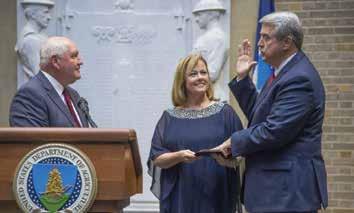
That’s exactly what he has done. For example, in November 2017, he visited India, his first international trade mission with a 50-person trade group that hosted more than 465 business-to-business meetings. Most recently he spent a few weeks in Japan and Jakarta, Indonesia working to open trade markets for U.S. farm commodities.
McKinney appreciates his USDA experience for several reasons.
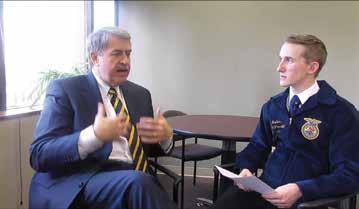
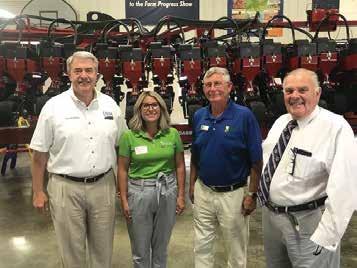
“Sonny Perdue was a tough but very fair leader,” he explained. “I was blessed because I had experienced
some of Mitch Daniels’ style, and he and Sonny Perdue are peas in a pod, to their great credit. I knew Mitch’s style and accountability priorities like ‘no excuses, sir, just deliver,’ ‘strategy drives tactics,’ and the realization that financial efficiencies can always be found in any government program. I relished having had these experiences going into the Under Secretary position. Perdue was keenly interested and proud of working with all states. He is a reformist and I had latitude and freedom to do the same in the international arena.”
McKinney said he kept U.S. farm families on his mind while working on expanding trade opportunities.
“My frequent, perhaps even daily thought was to find those policies or changes that if implemented, could open up another ton of soybeans, wheat, corn or cotton to be exported,” he explained. “And if that happened enough, it might allow a farmer to add just enough added profitability to afford to bring back a son or daughter into their operation. It allowed you to be incremental and that’s how trade works. I recall that at the outset of all trade meetings around the globe, I shared with my counterpart that I was there to work as hard for their exports as I was for ours. I’m thankful to have visited 28 countries – some of them two or three times – and ultimately logged 490,000 international air miles before Covid stopped us.”
McKinney describes himself as “farmer centric. What is good for family farmers is good for ag.”
This message resonates in his current position of CEO of the National Association of State Departments of Agriculture in Washington, D.C. “I love the culture, it’s about ag, not politics. NASDA is now 107 years of age and its membership includes the Directors, Secretaries, and Commissioners of Agriculture in all 50 states and four territories. NASDA’s scope transcends all of agriculuture – crops, food animals, companion animals, aquatics,
fiber, biofuels, and more. We are having fun in raising our members’ voices. We are diving into international issues in part to supplement the work of friends at USDA and USTR, but also because U.S. agriculture must raise its game internationally. We’re slowly building a cadence with the Asian Pacific rim and with it, trust across our countries.”
McKinney can cite a few specific career highlights that he remembers fondly. As State Director of Ag, he was proud to help ensure that Corteva remained in Indianapolis. McKinney helped pave the way for state and city officials to work together to ensure that Indianapolis became the world headquarters for Corteva. He also worked to ensure that Elanco, after being spun out of Lilly, also remained in the state.
Finally, to show thanks for all that FFA did for him and so many others, McKinney is happy to see that the National FFA Center planted on the Northwest side of Indianapolis and with it, the annual National FFA Convention.
His wife, Julie, is his biggest cheerleader. “With my own admiration, he lives, breathes and sleeps agriculture,” she said. “It’s such an attribute in the way he does it honestly and with a passion. It’s been fast-paced and demanding the last several years. He’s always ‘on.’ That’s just him. When you believe in it, it comes easily. Centered on public service and feeding the world are his ultimate goals.”
Don Villwock, long-time friend and former President of Indiana Farm Bureau, Inc., said McKinney has always had a farmer mindset.
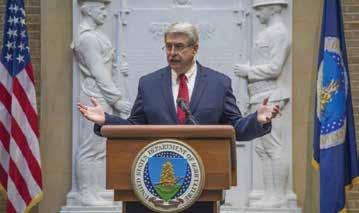

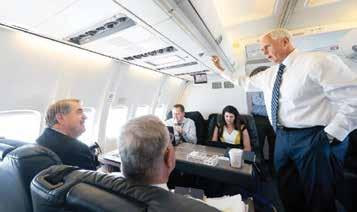
“Will this effort increase profitability? Will it benefit farmers? He now takes that into his higher positions,” Villwock said. “He uses a tremendous amount of common sense, which is rare in a lot of those jobs. We have someone in Ted that understands our challenges on a personal level. If I was picking an ag leader who’s had a great career path and is beneficial to all of us farmers, it’s Ted, and it is why I gave strong encouragement that he, not others, lead the formation of Indiana’s last major strategic plan for agriculture in 2016-17.”


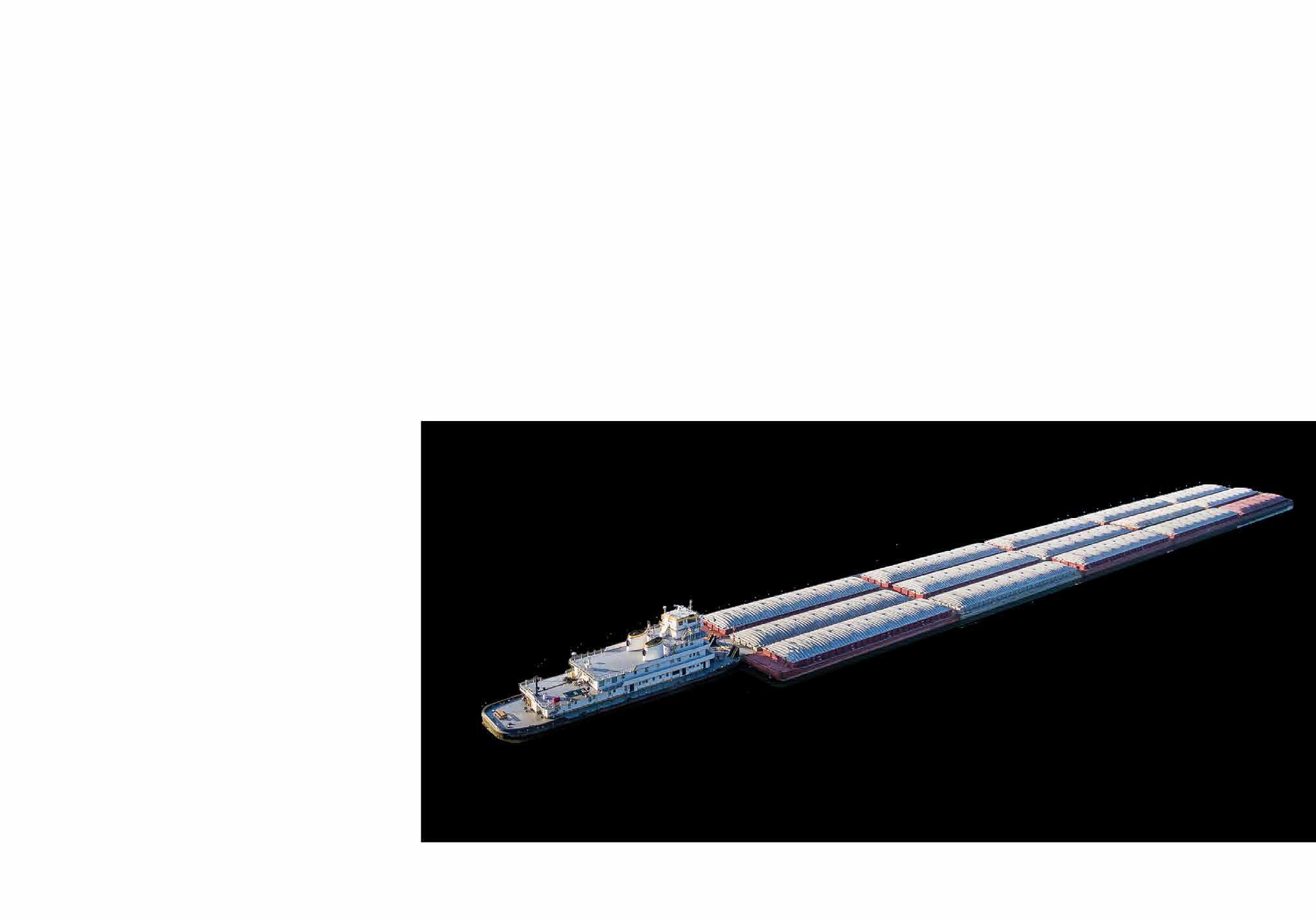


farm sustainability practices. The discussion highlighted USSEC’s contributions to China’s economic development and livelihood improvement goals – fulfilling the Chinese
Indiana farmers Matt Chapman from Springport, Ind., and Jim Douglas from Flat Rock, Ind., took part in the panel discussion to share their on-farm sustainability
Increased U.S. exports in China’s growing soybean, livestock and aquaculture industries relies upon documented U.S. farm sustainability efforts to meet demands by foreign importers. The panel discussion reaffirmed that importing U.S. soybeans meets China’s demands for food security, and it also aligns with China’s sustainability and environmental targets.


USSEC and ISA agree that maintaining open trade relations with China is critical. Ensuring seamless trade is essential for Chinese customers to have continuous access to high-quality U.S. soybeans. The open trade relationship between USSEC, ISA and China solidifies trust and collaboration, fostering a mutually beneficial partnership
With the help of USSEC, ISA Board members and staff are working together to differentiate, elevate preference and attain market access for U.S. Soy. The farmer-leaders of ISA are working to set the stage for another 40 years of soybean trade relations between the United States and China.
For additional information about the state’s soybean checkoff market development efforts, go online to
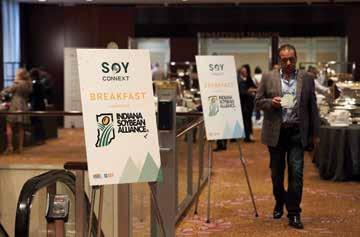 BY ROSALIND LEECK, Executive Director of Market Access & Strategy U.S. Soybean Export Council
BY ROSALIND LEECK, Executive Director of Market Access & Strategy U.S. Soybean Export Council

Soy Connext, the global U.S. Soy summit hosted by the U.S. Soybean Export Council (USSEC), hosted more than 700 participants, including international customers from 58 countries together with U.S. Soy farmers, related food and agriculture industry professionals, commodity exporters and others. They gathered in New York City on August 22-23, to discuss today’s global economy and the need for collaborative efforts among those who grow, sell and choose U.S. Soy.
Recurring themes throughout the conference included the need for a nutritious, safe, and affordable global food supply, economic viability for farmers and sustainable solutions. U.S. soybean farmers, including Indiana farmers, are viewed as major contributors to ensuring people around the world have access to protein-rich, sustainably sourced nourishment.
Conference presenters examined factors impacting the global economy such as international trade, supply chain challenges and innovations, and the need for global cooperation for mitigating climate change. They also had the opportunity to dive into more sector-specific information including soybean oil, soybean meal for livestock and poultry feed, soybean meal for aquaculture feed, and soy food and beverage production.
The event underscored that U.S. Soy is woven into the fabric of the global economy. U.S. soybeans, soybean meal and oil exported to over 80 countries help provide nutrition security for a global population.
“It’s a good time to be in agriculture,” said attendee Joe Stoller, a farmer from Bremen, Ind., currently serving as secretary for the Indiana Soybean Alliance (ISA). “People want to buy soybeans. There is a lot of demand for U.S. Soy that needs to be met.”

USSEC is dedicated to serving as a global connector. Soy Connext is one way USSEC brings together participants in the global soybean industry to maintain and grow worldwide collaboration.
Stoller experienced that connection firsthand during Soy Connext, when he saw customers he had met in Honduras earlier in August in the hotel elevator in New York City. He also connected with potential soybean buyers asking for soybeans specifically from Indiana. “I saw the value in bringing soybean buyers together here in the U.S.,” he said. “I learned about the global market and see potential for places where Indiana soybean farmers can invest to see fast market growth.”
Soy Connext attendees included representatives from markets where Indiana farmers have or soon will invest soy checkoff funds to foster that growth.
One of the markets ISA currently invests in is the soybean oil market in Columbia. Paola Muñoz, CEO
of Asograsas, or the Colombian Association of the Edible Fats and Oils Industry, shared her appreciation for U.S. Soy and ISA during Soy Connext.

“U.S. Soy truly cares about customers,” she said. “Soy Connext allowed me to learn what is coming in the market in the months ahead. We heard from experts we don’t have in Columbia and talked with farmers. It’s a very rich experience.”

She also participated in the Soy Oil Masters program hosted in Indianapolis. Those experiences have reinforced the value of U.S. Soy and oil sourced from U.S. soybeans.
“I believe in the sustainability of U.S. soybean because of the Indiana farmers we visited,” she said. “They explained what they do as they so kindly opened up their farms to us. I now understand the whole process of getting soybean oil from U.S. Soy, so it is easy for me and other program participants to tell that story to our customers.”
In the coming year, ISA plans to invest in the aquaculture market in Vietnam, which is served by about 200 feed mills. Duc Vo, chairman of the feed mill for Feed One Company limited in Vietnam, looks forward to more opportunities to work with U.S. Soy.
“I liked Soy Connext because it helped me get information and network with others in the industry,” he said. “It helps us stay caught up with technology.”
His company plans to do a project with USSEC, thanks
to ISA support. He purchases soybean meal derived from U.S. soybeans when it is available.
Vo believes U.S. Soy is good for the feed he produces for pangasius, the most common freshwater fish species aquacultured in Vietnam. He also has seen the benefits of the In-Pond Raceway System, or IPRS, promoted by USSEC, for fingerling production.
With over half of the world’s food and beverage companies publicly committed to sustainable agriculture, USSEC believes the demand for U.S. Soy is poised for growth. Customers like Muñoz and Vo reinforce the potential. Market development investments from Indiana farmers work alongside events like Soy Connext to help U.S. Soy reach that market potential.

“I believe in the sustainability of U.S. soybean because of the Indiana farmers we visited. They explained what they do as they so kindly opened up their farms to us.”
-- Paola Muñoz, CEO Asograsas


In an era where the need for global trade, sustainability and consumer demands intersect, initiatives like the U.S. Soy Export Council’s (USSEC) checkoff-funded Soybean Oil Masters program plays a vital role in educating and fostering connections within the agricultural, trade and culinary sectors internationally.
The program’s overarching objective is to provide international end users, crushers and influential groups in the food industry with a comprehensive understanding of U.S. soybean oil – and ultimately to increase demand. The education received covers various aspects, including nutritional benefits, practical applications, production processes and the sustainability of U.S. soybean production.
More than 1,000 participants from 12 countries have been engaged in the program since its inception. In the upcoming year, the program will reach more than 350 participants from Korea, Southeast Asia (Vietnam, Philippines, Thailand, Indonesia) and Latin America.
In mid-August, the Indiana Soybean Alliance (ISA) hosted a tour for current participants of the Korean Oil Masters

Program as a way to understand the variety of advantages delivered by U.S. soybean oil, particularly Indiana-grown and processed high oleic soybean oil, and how it impacts their food.
The tour itinerary spanned multiple locations across Indiana, providing participants with a diverse range of insights. The journey began on the farm of ISA Board director Allen Buchanan. This stop allowed them to witness the heart of Indiana agriculture firsthand, see high oleic soybeans being grown, and learn about the challenges and opportunities Indiana farmers face this year.
“Hosting this tour is something I really wanted to do,” Buchanan said. “I think it’s important for foreign buyers of U.S. soybean oil to see who grows this product. It’s important for them to see how we grow this crop. And, it’s very important for us to establish strong relationships. I believe we grow a very good product. When others see that, there’s confidence in that relationship.”
Participants also visited Purdue University’s Food Science department, where groundbreaking research and advancements are shaping the future of food and agriculture. Additionally, a visit to the Purdue Corn and

Soybean Innovation Center provided a glimpse into the cutting-edge technologies driving agricultural research and progress.
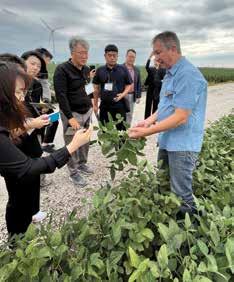

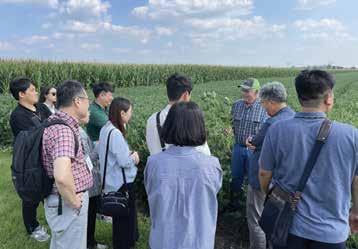
Participants also toured Louis Dreyfus Commodities in Claypool, Ind., and Kokomo Grain where they learned about logistics and operations behind soybean crush and trade. Louis Dreyfus is the largest integrated U.S. biodiesel plant, producing biodiesel from oil, soybean meal, glycerin and soy lecithin.
“The biodiesel that we produce here in Indiana is renewable and sustainable,” said Jeremy Mullins, Commercial Manager for Louis Dreyfus. “Foreign buyers are receptive to that message.”
Sustainability is at the forefront of today’s business and consumer agendas, and the demand for sustainable products continues to rise. This trend has a direct impact on the soybean oil industry, as consumers increasingly seek products that come from environmentally responsible sources.
U.S. soybean oil stands out with its low carbon footprint, making it an attractive option for businesses looking to align with sustainability goals. This sustainable advantage allows for the production of various products while preserving the environment for future generations.
The global landscape of the oil market has undergone a transformation due to the rise of Renewable Diesel (RD). This shift has particularly influenced U.S. Soybean Oil (SBO) exports, reshaping trade dynamics and market shares. Previously exporting around 1 million metric tons annually, the U.S. RD market developments have led to a shift, with South American countries, particularly Brazil, increasing their share in the market.
USSEC has taken proactive steps to quantify and differentiate the refining value of U.S. soybean oil compared to oil produced from other origins. Through collaborative efforts like the Soybean Oil Masters Program with international crushers, refiners and partners, USSEC has emphasized the intrinsic value of U.S. soybean oil. This has not only improved refining rates but also resulted in substantial cost savings.
The Korean Soybean Oil Masters program represents a convergence of education, sustainability and international collaboration. Through its holistic approach, it empowers stakeholders with knowledge about the advantages of U.S. soybean oil, its practical applications, and its role in a sustainable future. As global markets evolve and consumer preferences change, initiatives like this serve as beacons of innovation and cooperation, ensuring that the agricultural industry meets the demands of a changing world.
Whether it’s improving soybean meal to outperform the competition or promoting the sustainability of U.S. soy, the soy checkoff has been working behind the scenes to help farmers satisfy their customers’ needs. We’re looking inside the bean, beyond the bushel and around the world to keep preference for U.S. soy strong. And for U.S. soybean farmers like you, the impact is invaluable.
See more ways the soy checkoff is maximizing profit opportunities for farmers at unitedsoybean.org
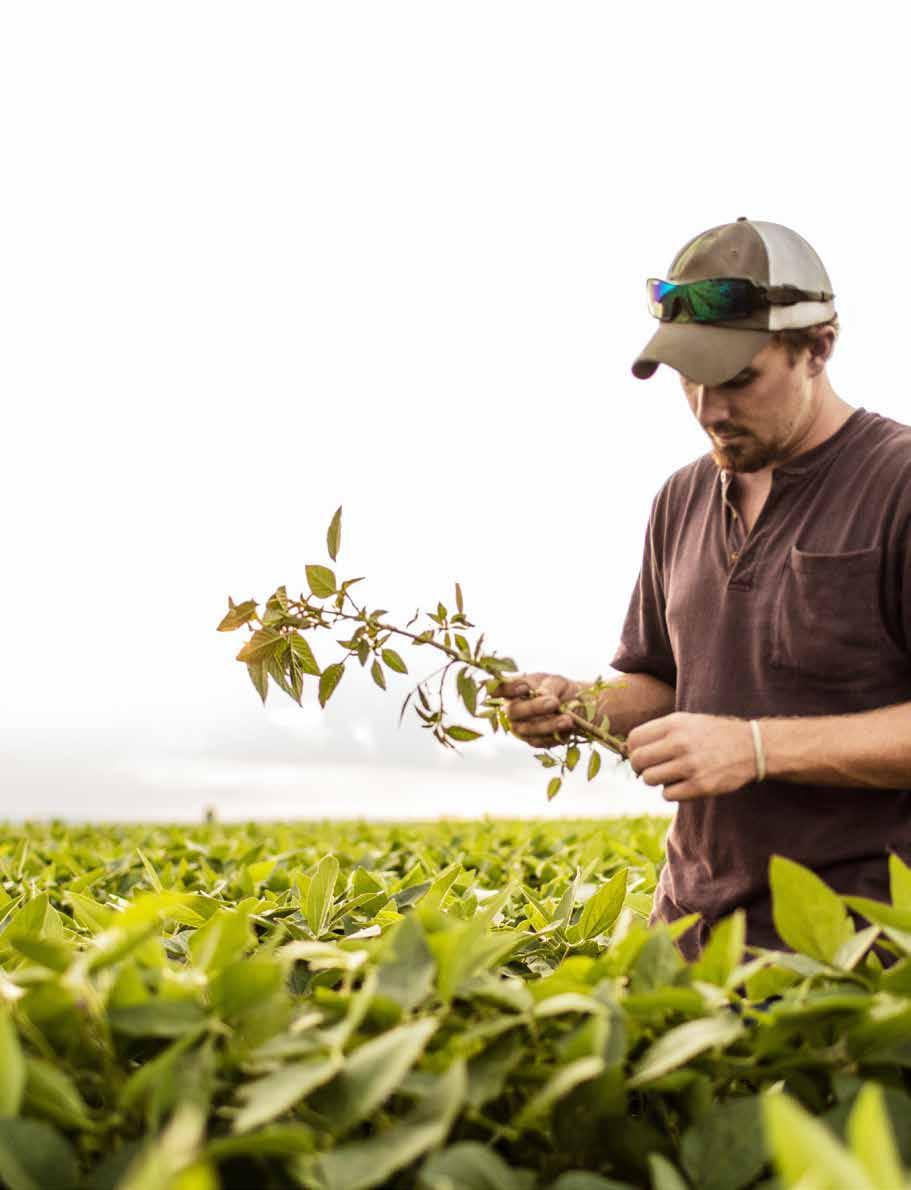

Growing more and better beans increases our bushels for the marketplace. Working with the Indiana Corn and Soybean Innovation Center, Purdue University, the University of Notre Dame, Indiana University and farmers themselves, the Indiana soybean checkoff invests in identifying solutions for environmental stressors, weeds, pests and input use and costs — all driving toward improved production and improved farm profitability.
For every dollar invested in research, $18 returns to the farm.* See research at work at Indianasoybean.com.




 BY USMEF STAFF
BY USMEF STAFF
Vietnam is an emerging market for U.S. pork, and as such has been identified as a target market for efforts of the U.S. Meat Export Federation (USMEF) along with the Indiana Soybean Alliance, the Indiana Corn Marketing Council and the National Pork Board. A centerpiece of these joint marketing efforts, the Porkstars chef competition, returned recently for a second season in Vietnam.
Top chefs from across Vietnam competed in preparing dishes featuring U.S. pork as the centerpiece, seeking to be named the 2023 Porkstar.
The competition, supported by the Indiana Soybean Alliance and Indiana Corn Marketing Council, was first held in 2022, bringing 30 leading chefs to Ho Chi Minh City to compete head-to-head. In season two of Porkstars, more than 100 chefs submitted pork recipes for consideration.
The top 20 chefs recorded
videos of their creations, which were featured on USMEF social media. Public feedback, with input from culinary experts, whittled those entries down to eight finalists who competed in a live streaming competition to select the ultimate Porkstar.
The social media aspect of the competition was added this year to expand the reach of the innovative recipes and to amplify the message of the quality, taste and affordability of U.S. pork.
The Vietnam market was targeted because its economy is picking up steam, opening new opportunities in a country where pork is already a vital part of the diet with annual per capita consumption near 60 pounds.
Recipes generated through the Porkstars competition will be promoted through USMEF to build demand for U.S. pork in a region where it faces stiff competition.
“Pork is already the preferred meat in Vietnam and as incomes rise, demand will grow for high-quality
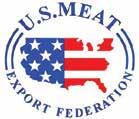
pork,” said Le Van Anh Tu, Vietnam representative for USMEF. “But we definitely have work ahead of us, as Vietnam is a price-sensitive market and consumers typically think of imported pork as lower-quality. So we are working to differentiate U.S. pork through chefs and other influencers on social media.”
That work is paying off, with exports of U.S. pork to Vietnam up sharply in 2023. Through July, the U.S. has shipped 2,666 metric tons (mt) of pork and pork variety meat to Vietnam, a 32 percent increase during the same period a year ago.
Vietnam’s retail sector.
“With more people working and more women working, they don’t have time to go to the wet markets to get their meat,” she said. “So you see a lot more consumers going into what we would consider more traditional Western markets. And at Indiana Soybean Alliance and Indiana Corn Marketing Council, we’re happy to be part of telling that story about how U.S. grown and raised pork really meets consumers’ needs.”
Recipes generated through the Porkstars competition will be promoted through USMEF to build demand for U.S. pork in a region where it faces stiff competition. Domestic pork production in Vietnam is still characterized mostly by small-scale producers. That pork production capacity was devastated by African swine fever beginning in 2019, opening the door to more pork imports.

In fact, the entire ASEAN region is seeing growth in U.S. pork purchases this year, with a remarkable 51 percent increase in volume on 2022. In addition to Vietnam, shipments are trending higher to the Philippines, Malaysia and Indonesia.
Recent forecasts from the Organization for Economic Cooperation and Development state that from 2022 to 2030, pork consumption in Vietnam will grow 3.1 percent per year to around 3.4 million mt. Consumption of chilled meat is increasing sharply thanks to convenience and quality factors.

Courtney Kingery, CEO of Indiana Soybean Alliance and Indiana Corn Marketing Council, said shifting demographics are creating new opportunities in
U.S. pork has achieved gains despite a competitive disadvantage, as many countries enjoy more favorable tariff status. Russia, which has been a leading supplier of pork into Vietnam, enjoys zero duty access to the country thanks to an agreement with the Eurasian Economic Union. Canadian and European pork enter Vietnam at reduced duty rates.
This is why U.S. pork must be differentiated by its quality and the reach of the social media influencers and chefs featured in the Porkstars competition is key. Chefs featured in the competition impact grocery buying decisions and help carry the message of the quality and value of U.S. pork products while showing the ease of use in creative new recipes.
Overall, U.S. pork is enjoying strong export growth in 2023, with global sales volume up 13 percent on last year and export value up 10 percent.
“With more people working and more women working, they don’t have time to go to the wet markets to get their meat. So you see a lot more consumers going into what we would consider more traditional Western markets.”
-- Courtney Kingery







The Indiana corn checkoff backs research to find new corn uses. From fuel and bio-based chemicals to corn plastic — we're finding new corn uses to increase corn value

Learn more about new uses for corn at incorn.org





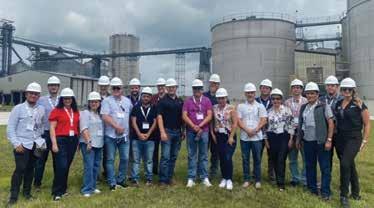
 BY USGC STAFF
BY USGC STAFF
To showcase the benefits and opportunities of blending ethanol with gasoline, the U.S. Grains Council (USGC) hosted a Latin American (LTA) delegation with representatives from Guatemala, Costa Rica, Panama, Chile, Peru and Colombia in August. The group was made up of journalists and public officials from countries already blending ethanol, looking to increase their established blending percentage or considering initiating biofuel programs in the coming years.
“There is nothing more enriching than learning first-hand about the ethanol value chain and about the positive impacts and benefits derived from the production, marketing and use of ethanol,” said Juan Diaz, USGC LTA regional ethanol consultant. “Being able to demonstrate the process of ethanol production and the use of biofuels in both commercial and high competition vehicles is the best evidence for those countries that are starting with biofuels programs and to show the opportunities that lie ahead.”
The trade mission showcased the benefits of ethanol from a communications and media perspective. The itinerary provided participants with an overview of the impact of ethanol in at least five areas of interest to Latin American countries: agricultural and social development opportunities; environmental and health benefits of ethanol use; vehicle performance and technical aspects of automobiles; economic issues and financial considerations; and U.S. biofuels regulatory framework.
“The Americas produce and consume the most ethanol proportionally. However, several countries, especially in Central
America, still do not have ethanol-gasoline blending mandates. The Council is helping these countries start blending, showing the positive economic, environmental and social impacts of using ethanol,” said Federico Salcedo, USGC regional ethanol consultant.
The mission began in Washington, D.C., where the team met with USGC leadership, including USGC President and CEO Ryan LeGrand and Mackenzie Boubin, USGC director of global ethanol export development, to learn more about the Council’s work around the globe to develop and expand the worldwide ethanol market. The delegation also met with representatives from the U.S. Department of Agriculture (USDA), Renewable Fuels Association (RFA) and Growth Energy to learn about the evolution of U.S. biofuels policies, domestic industry development and market prospects.
The team continued its tour in Indiana where, with the support of the Indiana Corn Marketing Council (ICMC), they met with several Council members and learned first-hand about the ethanol production and value chain. In Indiana, the delegation toured USGC Past Chairman Josh Miller’s farm, POET’s Alexandria, IN, ethanol plant and a Casey’s gas station. The delegation also experienced the benefits of ethanol in highperformance vehicles by attending car races at Indianapolis Motor Speedway. USGC’s ethanol trade education efforts continue to focus on critical public and private sector stakeholders in LTA to promote ethanol and gasoline blending, highlighting the environmental, economic and social benefits and continuing to open global markets for U.S. ethanol.
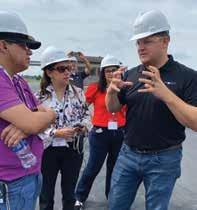
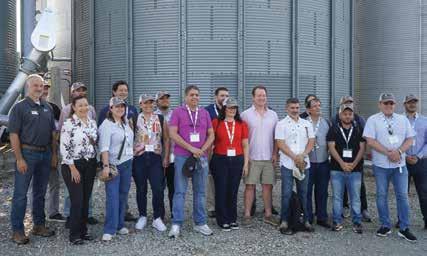 BY DAVE BLOWER JR.
BY DAVE BLOWER JR.
Indiana farmers know how to grow corn.
Indiana is the fifthlargest corn-producing state in the country, according to the USDA. Indiana ethanol producers know how to turn that corn into a valuable renewable fuel. The state’s 15 ethanol plants produce more than 1.4 billion gallons per year.
Corn checkoff organizations, such as the Indiana Corn Marketing Council (ICMC) and the U.S. Grains Council (USGC), make it a priority to find buyers for ethanol and improve the value of Indiana’s corn crop. To accomplish this mission, ICMC and USGC hosted opinion-makers, communication and public officials from Panama, Costa Rica, Guatemala, Peru, Colombia and Chile for a tour of Indiana’s ethanol supply chain.
The tour started in the cornfield of an Indiana farm, followed a grain truck to a nearby ethanol plant, watched ethanol filling gas tanks at a fuel station, then experienced the power and speed of ethanol-fueled racing cars. The tour attendees learned about the U.S. ethanol industry, the U.S. Renewable Fuels Standard (RFS) and the benefits associated with the use of ethanol for transportation. The tour provided firsthand information to Latin American media, allowing them to gather objective details of the U.S. ethanol sector and its potential use in Latin America.
“The purpose of this tour is to highlight the reliability, economic and environmental benefits of U.S.-produced
ethanol to people who influence the buying decisions of many people from Latin American countries,” said ICMC Biofuels Director Helena Jette. “We also like to show the high-performance aspect of ethanol. By taking them to see the Shift S3ctor Indy Airstrip Attack halfmile exotic drag racing at the Marion airport where drivers are using E85 racing fuel and the NASCAR Brickyard 200 race where drivers are using E15 at the Indianapolis Motor Speedway, these influencers were able to see that ethanol enhances performance.”
She added that ethanol helps all Hoosiers by reducing greenhouse gas emissions and improving air quality. In fact, the American Lung Association reports that ethanol improves air quality by replacing some of the most harmful components in gasoline. This results in 43 percent fewer greenhouse gas emissions than gasoline. Indiana ranks as the 6th-largest producer of U.S. ethanol. The Hoosier State produces nearly 8 percent of the total U.S. ethanol output. Collectively, Indiana’s ethanol plants consume about 45 percent of Indiana’s total corn crop – around 450 million bushels.
The USGC brought the tour group to one of its leaders to start the program. Recent USGC President Josh Miller, a farmer from Anderson, Ind., hosted the tour and explained how he grows the crop
that makes the fuel. Miller said, like many Hoosier farmers, much of his corn crop goes toward ethanol production.
“Almost half of Indiana’s corn is converted into ethanol,” he said. “Ethanol positively serves our state’s economy, environment and local farmers. The U.S. Grains Council and the state’s corn checkoff are doing all they can to help fuel retailers take advantage of the benefits of ethanol blends. One of our priorities is to spark conversation and collaboration across the industry. Tours like this support that mission.”
The USGC develops export markets for U.S. barley, corn, sorghum and other related products including distiller’s dried grains with soluble (DDGS) and ethanol. With a full-time presence in 28 locations, the USGC operates programs in more than 50 countries and the European Union. USGC believes exports are vital to economic development and to U.S. agriculture’s profitability.
The Latin American visitors next toured the POET ethanol biorefinery in Alexandria, Ind. This state-of-theart bioethanol production facility consumes more than 21 million bushels of locally grown corn to produce 90 million gallons of bioethanol annually.

The next stop was a Casey’s gas station in Marion, Ind. Many Casey’s gas stations sell higher blends of ethanol such as Unleaded 88, a blend of 15 percent ethanol with 85 percent gasoline, and E85, a blend of 85 percent ethanol and 15 percent gasoline. The Marion store sells each of these blends, too. ICMC has helped Casey’s expand its ethanol offerings through a program that pays for pumps that sell higher ethanol blends.
The rest of the tour was dedicated to racing. The attendees watched timed racing at the Marion, Ind., airport called the Indy Airstrip Attack, which is a Shift S3ctor event. This racing features all varieties of sports cars and motorcycles racing a stopwatch for the best times over a straight, half-mile track. All of the cars were powered by ethanol-blended fuels, and the race itself was sponsored by ICMC.
Shift S3ctor co-founder Jason Huang said the maximum numbers of drivers signed up to participate in this year’s race. “From a race weekend perspective, it was incredible. We were at max capacity in terms of race cars. We had nowhere left to park them,” he said. “It was amazing to see that many cars come out to Marion, 95 percent of those cars were not even from the state of Indiana.
For more details about Shift S3ctor, go to its website at shifts3ctorcom
Aside from being entertaining for the Latin American visitors, Jette said auto racing is an excellent way to showcase the high performance of ethanol-blended fuel. Ethanol has the added benefit of being more environmentally friendly than petroleum-only fuels.
The next two races were at the famed Indianapolis Motor Speedway (IMS). On Saturday, August 12, the attendees watched the NTT IndyCar Series drivers race the Gallagher Grand Prix on the IMS road course. On Sunday, Aug. 13, the Latin American influencers watched NASCAR drivers compete in the Verizon 200 race on the IMS road course. The NASCAR drivers were also racing on corn ethanol-blended fuel.
“This weekend’s events were more than a good time watching all types of racing,” Jette said. “This has been an excellent opportunity to share the story of Indiana-made ethanol.”
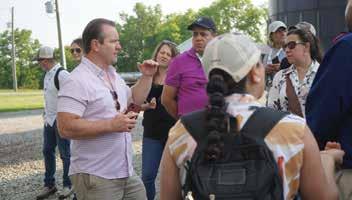
The Casey’s General Store fuel sign shows that higher blends of ethanol cost less than standard fuel. The Regular unleaded fuel, which is blended with 10 percent ethanol, costs 10 cents more than Unleaded 88, a blend with 15 percent ethanol, and 60 cents more than E85, a blend of 85 percent ethanol with 15 percent petroleum.

Growing domestic demand for corn starts right at the pump. Ethanol continues to be a domestic driver of corn value. Working with automakers, new technologies, industry partners, retailers, fuel suppliers and consumers, checkoff investments continue to be used to promote higher ethanol blends and use.
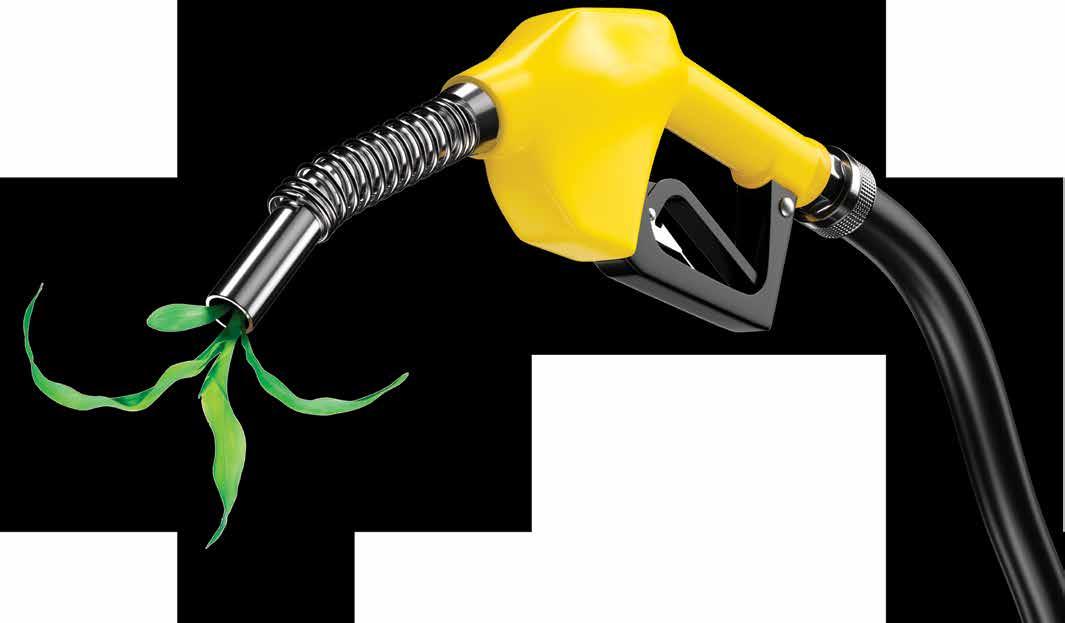


Learn more about fueling corn value with ethanol at incorn.org.


Farmer interest in high oleic soybeans and demand for the product continue to grow. The United Soybean Board (USB) recently hosted an event in Hoagland, Ind. to highlight the opportunity for farmers to earn a premium.
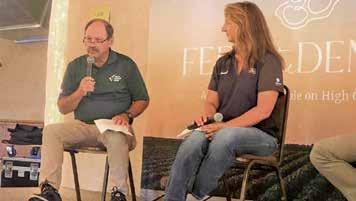
Cass County, Ind., farmer Kevin Wilson told attendees about his experience growing high oleic soybeans on his farm during the past several years. High oleic soybeans launched commercially in 2012. He said many of growing pains that come with raising something new have been ironed out, and now many farmers are enjoying a premium.
“The premium this past year was between $2 and $2.25 depending on your location, delivery versus storage, and different things,” he said. “I’ve been hearing the premium for the 2024 crop could be somewhere around $1.75 a bushel. So that’s a nice bump. When I first started planting high oleic soybeans, the premium was around 50 cents. So, we’ve bumped that up because there is more demand for it.”
Wilson said management of high oleic soybean varieties is similar to conventional soybean varieties.
According to USB, high oleic soybeans are currently grown in 13 states throughout the U.S. soybean belt with the highest concentration of acres in Indiana and Ohio. Those farmers grew high oleic soybeans on more than 800,000 acres in 2022.
Indiana farmers planted nearly 500,000 acres of high oleic soybeans in the same year.
oleic soybean varieties to meet the rising demand for high oleic oil. USB officials said the soy checkoff is committed to help expand contracted acres and delivery locations to make this specialty soybean available to more farmers.

Farmers are also touting the health benefits of high oleic soybean oil.
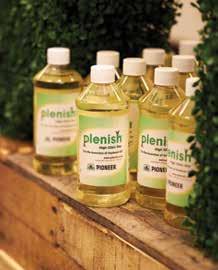
“The soybean oil we’re producing is healthier. The more that we can sell to the food industry brings more value to the oil, ultimately benefiting soybean growers,” Wilson said.
He added that the oil benefits consumers and the food industry. High oleic soybean oil contains zero transfat, lower saturated fat, and three times the amount of beneficial mono-unsaturated fatty acids compared to many conventional vegetable oils.
“Consumers can get all the positive benefits that are heart healthy and what many have been looking for,” Wilson said.
USB says high oleic expands markets for soybean oil demand in frying and baking and high-heat conditions. It doesn’t take away demand from commodity soybean oil.
USB
high
markets for soybean oil demand in frying and baking and high-heat conditions. It doesn’t take away demand from commodity soybean oil.
The soybean industry continues to work to increase acreage of high
There are many food retailers using high oleic soybean oil including: Gainbridge Fieldhouse, Purdue University food service, Indiana State Fair vendors and concessions at Purdue, Indiana University and Indianapolis Indians games.
Can you ask your cornfield at the beginning of the growing season if it’s feeling sick and needs to be treated for fungal infection? Sure, but you’ll probably only get weird looks from neighbors or farmhands.
However, with recent research and a concept born from a new company called Insignum AgTech, your corn plants might be able to volunteer that information as clearly as “treat me with fungicide” written in marker on a sticky note. Kyle Mohler, founder and CEO of Insignum, used gene-editing technology to develop a product that allows corn plants to display purple dots on their leaves at the onset of disease stress. This warning allows time for farmers to treat their field long before other symptoms are visible.
“For a lot of plant stress, by the time you see it, it’s already too late to do something about it,” said Mohler, who grew up on a corn and soybean operation in Boone County, Ind., where his brother and father continue to operate about 3,700 acres.

Insignum AgTech technology turns corn purple when pathogens first infect the plant, before the damage is done. This technology and protect crops from devastating disease; or if no disease is present, this can save costs on unnecessary crop protection.
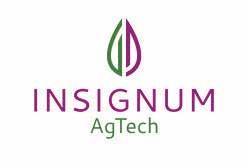
“You see insect damage when you’ve got holes in your leaves or the corn is laying on the ground,” he said. “You see nematode pressure at the end of the year when they start to die early, and you see diseases when the plant is starting to die and turn yellow – you can’t heal problems usually once you see them in crops, so what we’re hoping to do is to get that early warning sign to help them right when it very first starts, so you can get ahead of the damage.”
Grain crops do not typically come in the color purple, but
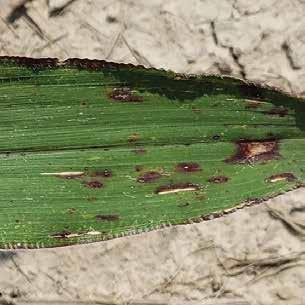
Mohler explained that plants do have the capacity to express purple pigment already in their genes. What the human eye sees as black pigment on a plant is actually a very concentrated purple. This means Mohler can coax colors ranging from red to purple or blue, even out of corn leaves that we would normally only think of as green. And it’s not just corn. Mohler said soybean plants have the same capability to produce different pigments, and Insignum fully intends to work on soybean versions of the technology.
“There is nothing transgenic in it; we are just putting two biological systems together that are already present,” he explained. “As soon as a spore is trying to infect a leaf, the corn is putting on its defense system to try to stop that infection, so we take advantage of that genetic reaction to turn on a different gene than it normally would.”
Once infected with disease, a corn plant would normally use a certain gene to trigger its natural defense system, but not the gene that triggers color production. What Mohler has done is create a new piece of DNA by joining those two genes to flip a genetic “light switch” that triggers the plant to produce purple spots at the onset of disease. He can also put together a gene that could flip a switch to produce a different color, depending on what kind of threat the plant was facing.
“In the future, we could create multiple different switches for specific problems. We could use our red color to signal for insects, we could use a blue to signal for disease or low nitrogen; we could color code different problems so that
farmers could make certain applications when they need them, and only to the sections of the crop that needs it.”
This turns into a lot of economic savings when it comes to crop inputs, which is how Mohler came up with his idea initially. After earning his undergraduate and master’s degree from Purdue, he went to the University of Edinburgh in Scotland to complete his PhD in plant science. When he came back to his family farm in Indiana, something was
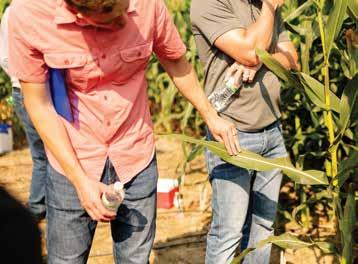
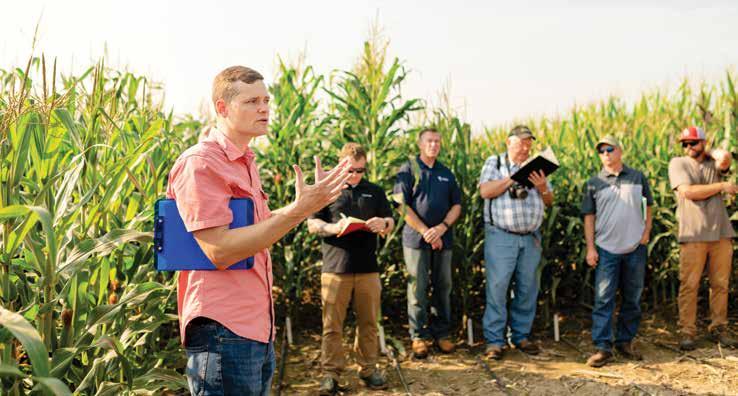
different. The operation had started to utilize fungicides.
“They would buy product in the middle of the winter when they could get a discount on it, and I said, ‘why are you buying fungicide in the middle of the winter for corn that you haven’t even put seeds in the ground yet for?’ And it’s because if you wait to see if a fungal disease happens or if you realize it happens it’s already too late. So, it’s part of our plan, and it makes money on average – maybe not every year and maybe not every field, but most of the time it does.”
Though he understood the reasoning behind blankettreating a field with fungicides, Mohler thought there had to be a better way. Widespread treatments may not pencil out economically because the producer is spending money on the entire field even though only certain parts of the field might be affected, or such a disease may not develop at all. But there are also environmental and fungicide or pesticide resistance-related downsides to treating an entire field.
“From an agronomy perspective and from a scientific perspective, resistance is a real consequence of overusing these things,” he said. “But to an individual farmer on an individual year, that’s not as much of a concern right this minute.”
The specificity of knowing not only if your field is stressed but also knowing what part of it is affected and what kind of stress is taking place is an extremely valuable part to Mohler’s technology. Specificity is also important when a producer uses other technologies such as drones or UAVs to detect problems in the field.
“Part of the struggle with the drone technology is that plants have a lot of overlapping symptoms, and it’s hard to know what exactly to treat for,” he said. “If they turn yellow or show an infrared signal or a thermal signal on the aerial imagery, there’s still a few things that could be wrong and require an agronomist or farmer to walk out to the field and diagnose exactly what the problem is.”
With Mohler’s tech, there is no need for a second opinion. The color of the dots on the corn leaves should manifest what precisely is setting off a plant’s defense system. For three years now, Mohler has been testing different types of stress on the edited corn plants, but the purple only shows when a fungal disease is causing the problem.
“We’ve seen it be very specific, and it reacts to only diseases that we have engineered it too,” Mohler said. “We have even tried with different diseases over and over again, so we’ve seen drought stress and heat stress and low fertility and insect damage, but this technology does not react to any of those. We see purple only when it’s a fungal infection.”
Most of the field tests of Mohler’s technology have taken place right on his family’s farm in Boone County. On-farm experimenting is something he began back in his FFA days when he did a Supervised Agricultural Experience project on production agriculture using his father’s cropping equipment and a couple fields he rented from a neighbor.
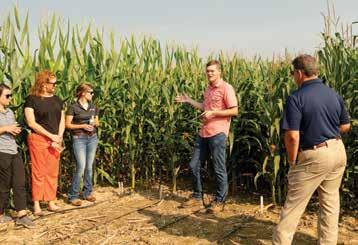
“If I were to summarize my history, I’ve spent just as much time with my hand holding the wheel of a tractor as I have holding a pipette on a science lab bench.”
Mohler expects his initial product will be able to detect any fungal infection in corn, including longstanding diseases like northern corn leaf blight, grey leaf spot and southern rust, along with newer and emerging diseases such as tar spot. On the soy side, he said white mold and soybean sudden death syndrome are among the diseases he believes the technology will be able to detect.
“What’s interesting about sudden death syndrome is that there are no treatments for it – maybe there’s some fairly early applied seed coatings for it, or early treatments that might have some impact on sudden death, but the infection cycle is the beginning of the season,” he said. “But
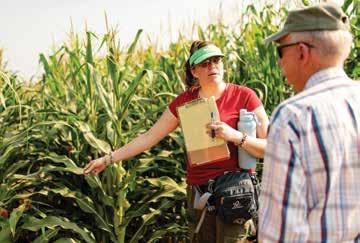
you don’t see it until months later, so by the time you see it it’s way, way too late. If we could get an early warning on it, that would be huge, and we can start to think about applying products to try to treat it. We just don’t have any options on the market for that right now.”

As promising as Insignum’s research is, Mohler said they are about five years away from bringing the product to market, as it needs to be licensed by seed companies along with other legal checkpoints, deregulation and multiplying the seed. However, Mohler said in a year or so producers may have the opportunity to help expediate the process.
“Part of that really long development cycle means that we need to take investment,” Mohler said. “It can be helpful for us if we get some kind of statement of interest or other support from farmers and agronomists and other people at this very early stage. One of the things that we hope to do, maybe not by next year but the year after, is to do something like a beta test if we get our seeds deregulated by next year and have seeds that are available to pass out we would like to give out garden packets that people could grow in their garden – not on their commercial fields but just to take a look at the technology.”
Mohler asks that farmers keep an eye on his company and sign up to be early testers, not only to see how the product works, but also to give feedback.
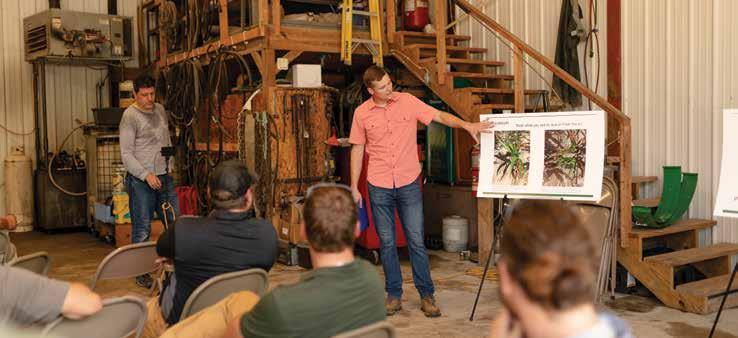
“I was very fortunate from the beginning to have the support of Purdue on this project working through my post-doc degree, and then after the project they’ve
released that technology back to me,” Mohler said. “But in the meantime, they’ve now invested in our company, so I hope they can get a really big return for all of the hard work they’ve put into me and the company over the years.”
To celebrate the return of the Indiana State Fair, Indianapolis Indians fans enjoyed four, fair-themed concession items during State Fair Foods Week presented by the Indiana Soybean Alliance (ISA) during an August 8-13 homestand at Victory Field. Donut burgers, elephant ears, pork parfaits and pork tenderloins were available at The Range concession stand located in the Center Field Plaza.
ISA and Indians officials said this is the beginning of an opportunity to sell more concessions at the ball park cooked in healthy high oleic soybean oil.
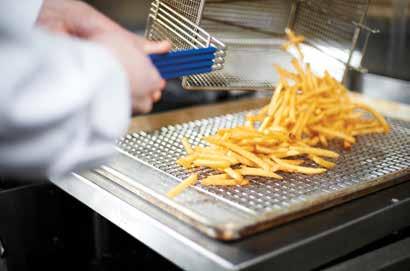
“We were excited to offer Indians fans four fair-themed concessions cooked with a healthier high oleic soybean oil provided by the Indiana Soybean Alliance,” said Joel Zawacki, Indianapolis Indians Assistant General Manager of Corporate Sales and Marketing. “With Hoosier farmers as the top producer of high oleic soybeans in the world, bringing the Indiana Soybean Alliance on base not only as the title partner of State Fair Foods Week but as the official provider of high oleic soybean oils used in all concession stands on game days and for stadium events like SWING is a grand slam.”
Descriptions of the four fair-themed concession items available to fans at Victory Field include:
• Donut Burger: grilled bacon cheeseburger sandwiched between two glazed donuts.
• Elephant Ear: fried to golden perfection and topped with powdered sugar.
• Pork Parfait: layered with mashed potatoes, baked beans, pulled pork and bacon.
• Pork Tenderloin: sandwich served with lettuce, tomato and onions.
“There are few things that are more American – or more Hoosier – than state fair food, pork tenderloins and baseball,” said ISA Chair Mike Koehne, a farmer from
Greensburg, Ind. “This is a great opportunity for Indiana’s 20,000 soybean farmers to show off one of their leading products – high oleic soybeans. Indiana is the leading producer of high oleic soybean oil worldwide. This is a healthy oil that is better for consumers than conventional cooking oil, making it a local and quality product everyone benefits from.”
In addition to being the world’s leading producer of high oleic soybean oil, Indiana is a leading state in pork production.
High oleic soybean oil is a new monounsaturated fat that is more heart healthy, according to nutritionists. The oil can handle higher cooking temperatures for longer periods, which means that it lasts longer for food preparers – making it more economical. Indiana farmers are paid a premium for growing high oleic soybeans by companies who market them to food processors.
ISA is also a frequent partner of the Indiana State Fair. The Glass Barn is a permanent structure at the fairgrounds and one of ISA’s primary educational facilities to teach consumers about the work and products of Indiana’s farmers.
“To create a better understanding of Indiana agriculture and how we grow our crops, we often need to bridge the gap that exists between farmers and our neighbors –both rural and urban,” said Koehne, who grows high oleic soybeans on his Decatur County farm. “The Glass Barn, for many years, has effectively taught folks about farming at the Indiana State Fair. We believe this partnership with the Indians also fits with our goals at the checkoff. It creates a new market for Indiana soybeans; it adds value to something we already produce, and it educates the public.”
Single-game tickets are available along with group and premium reservations. For more on Indianapolis Indians baseball, visit IndyIndians.com or contact the Victory Field Box Office at 317-269-3545 or go to Tickets@IndyIndians.com

From distributing over 20,000 boxes of soybean crayons to educating students at the Glass Barn, to partnerships with American Lung Association and Greater Indiana Clean Cities, ISA is invested in promoting the positive impact of soybeans to millions of consumers.




We're coloring an impactful soybean story. See how at Indianasoybean.com.



FOR WE LIVE BY FAITH, NOT BY SIGHT.
II CORINTHIANS 5 : 7
